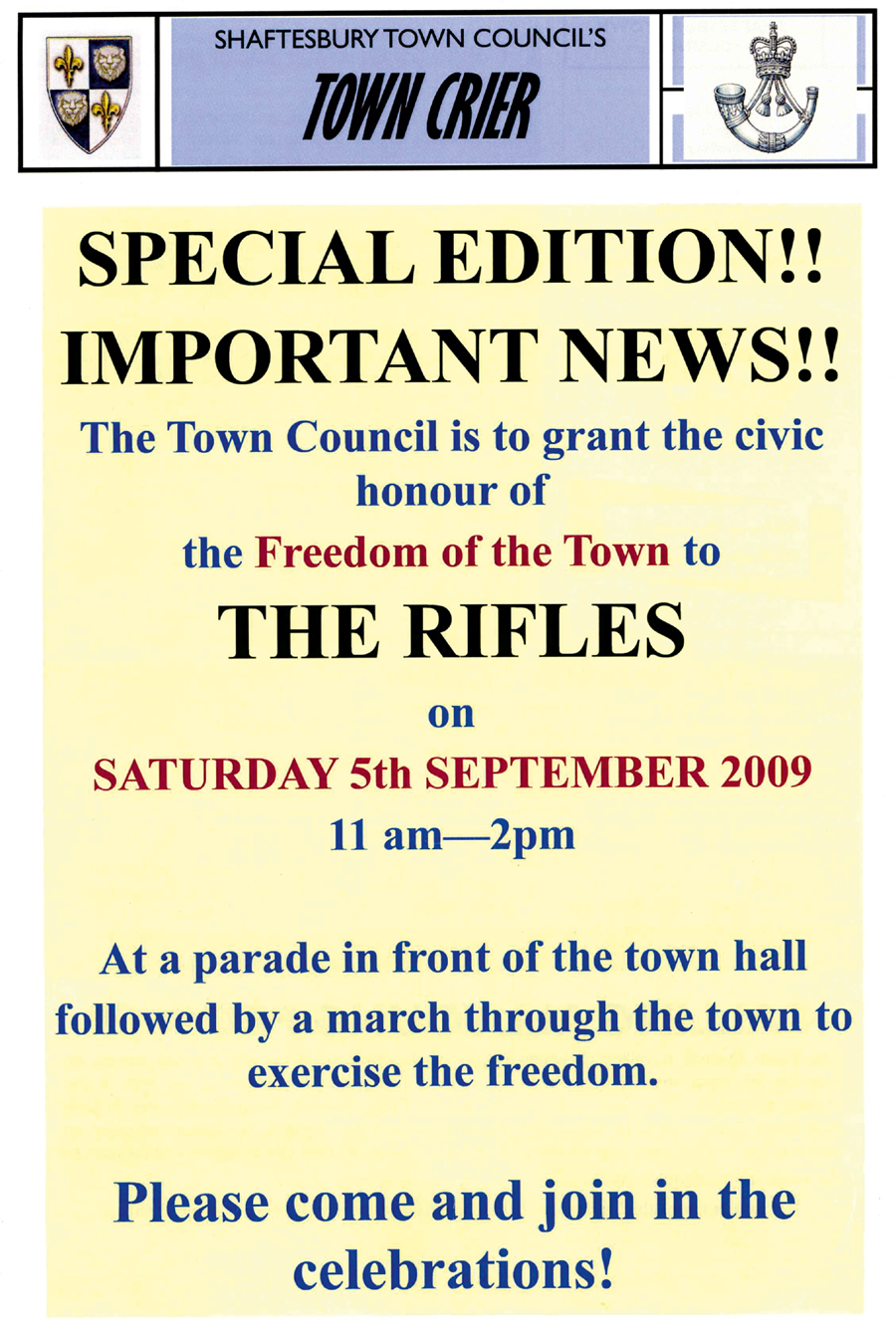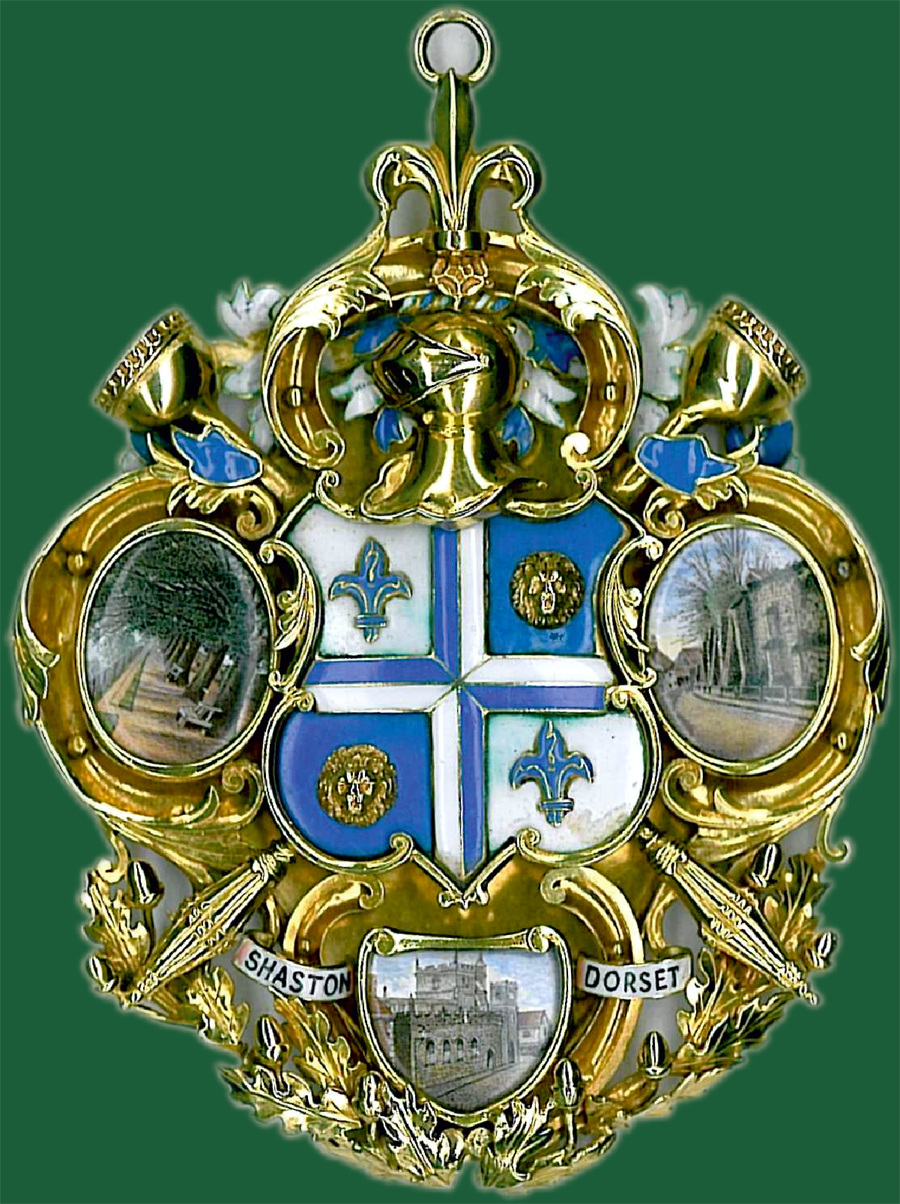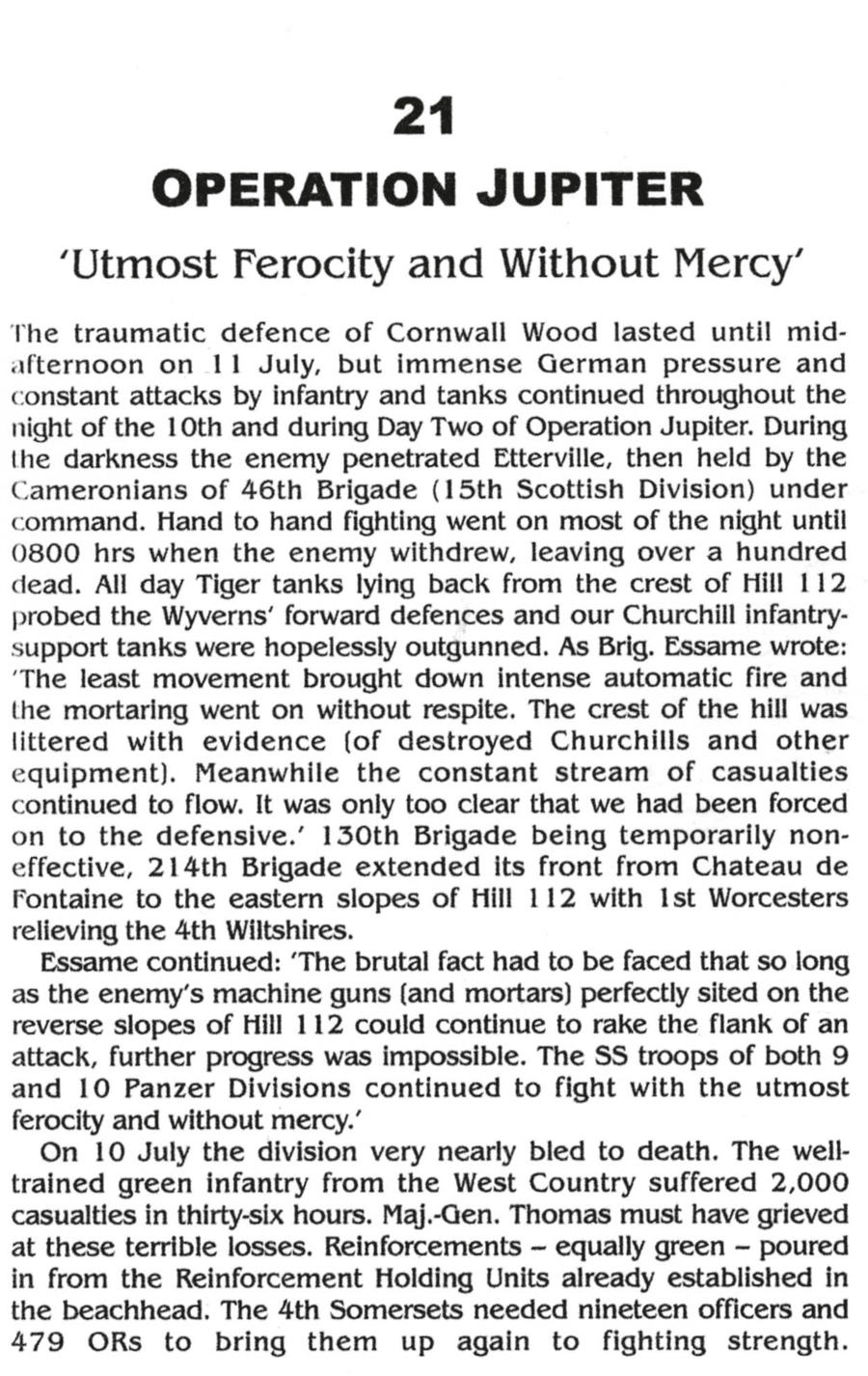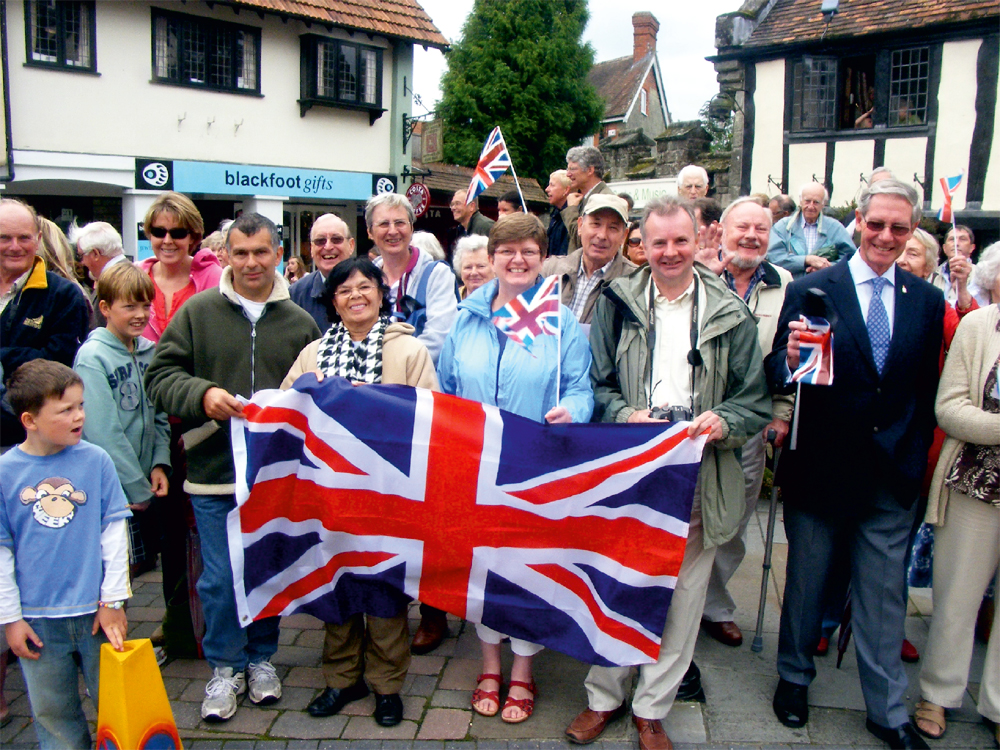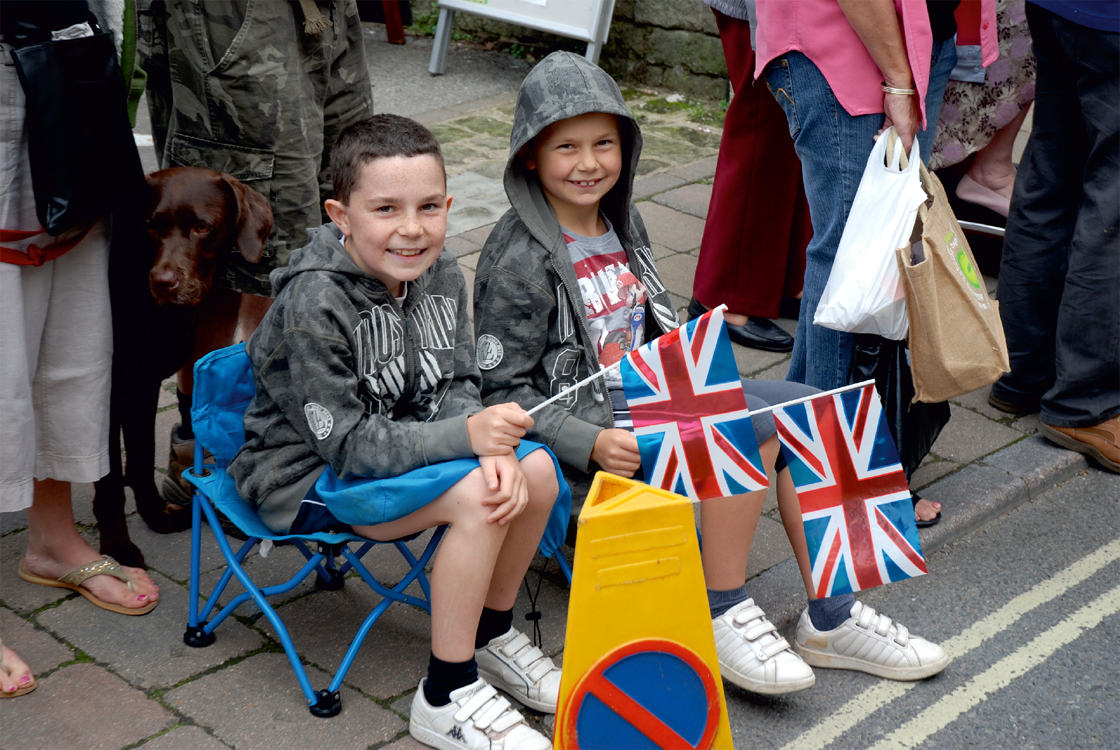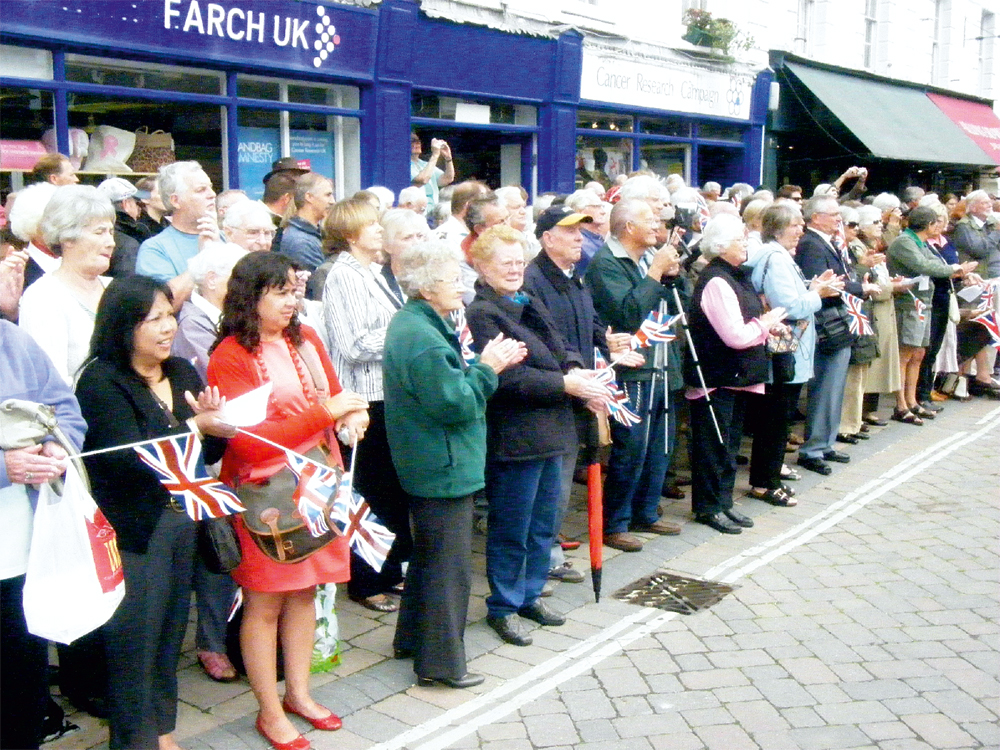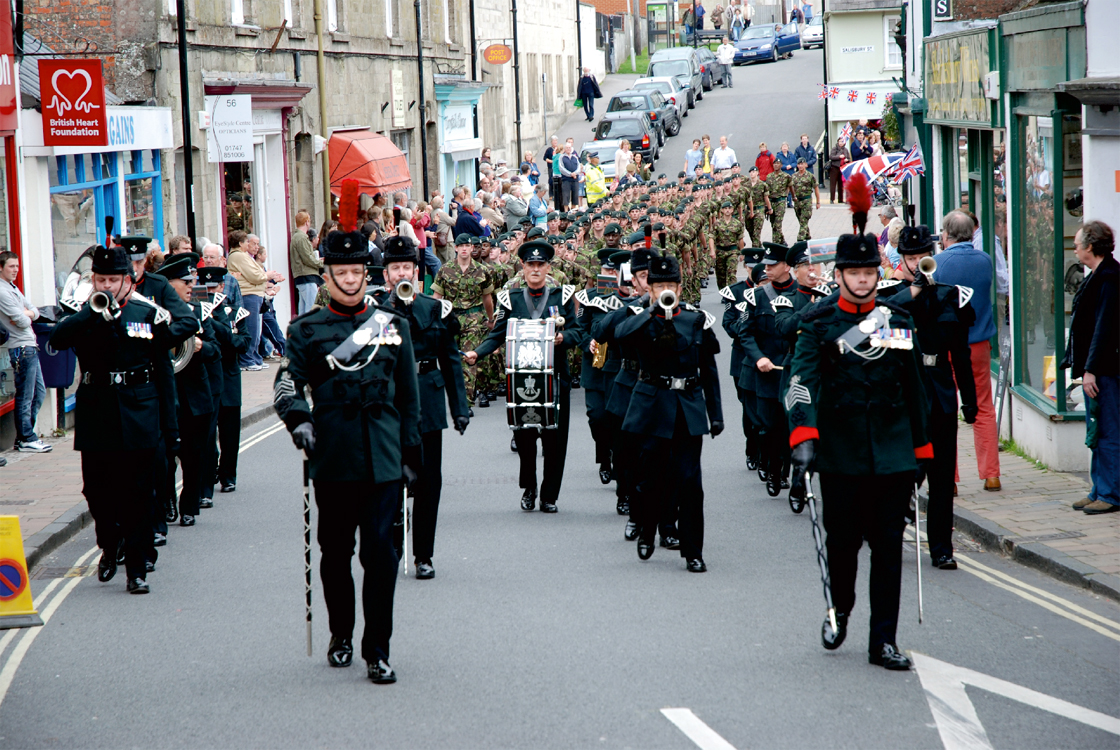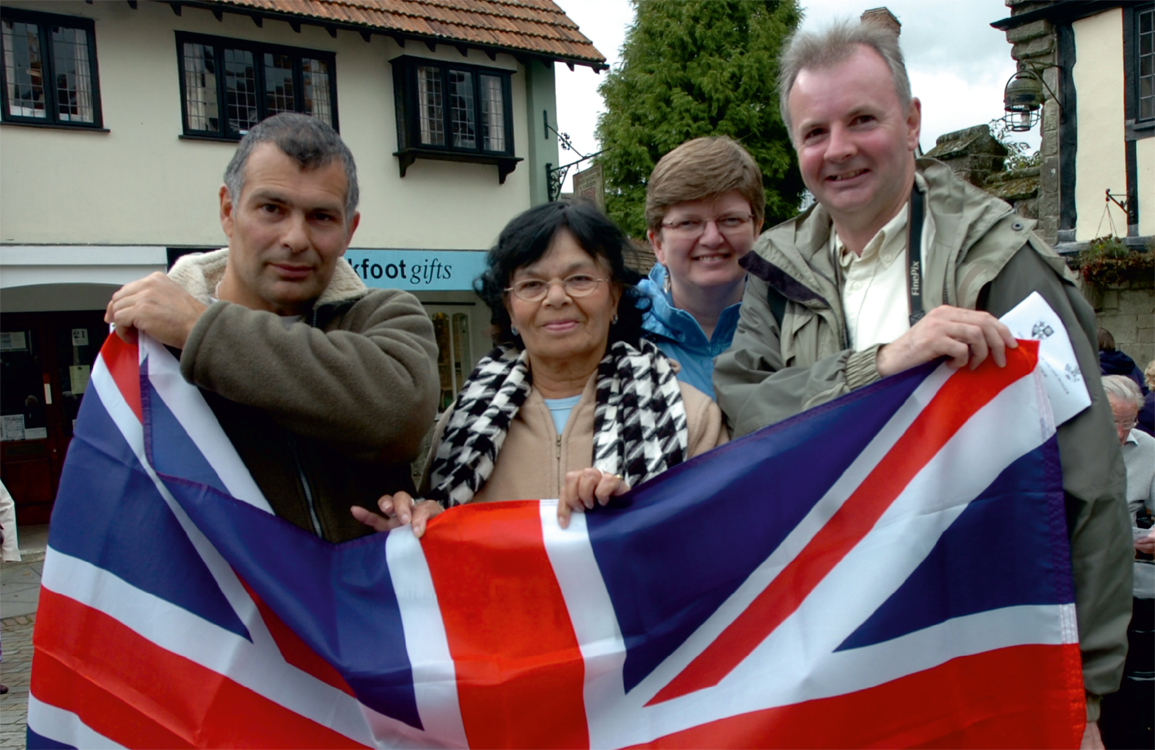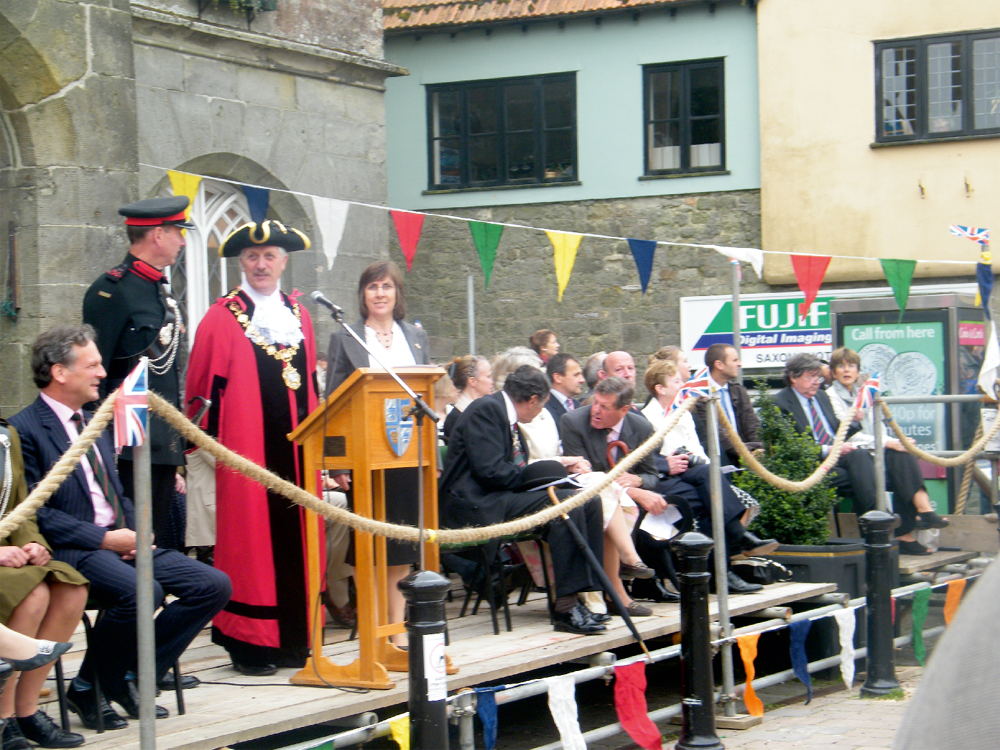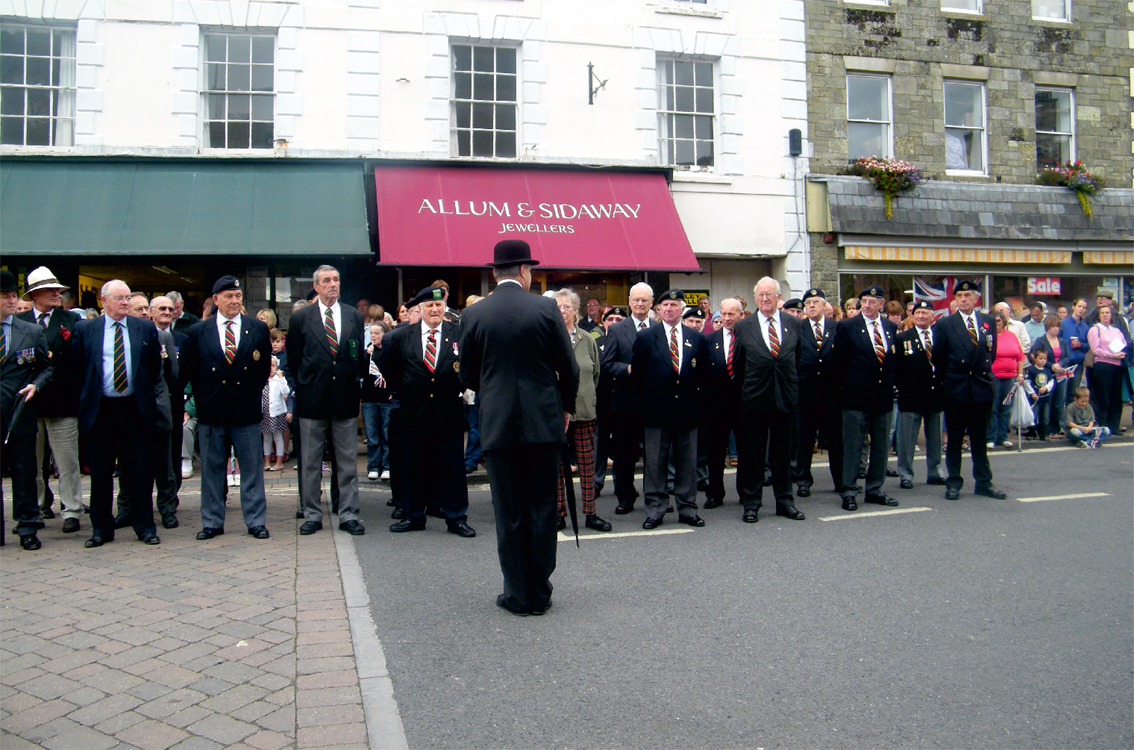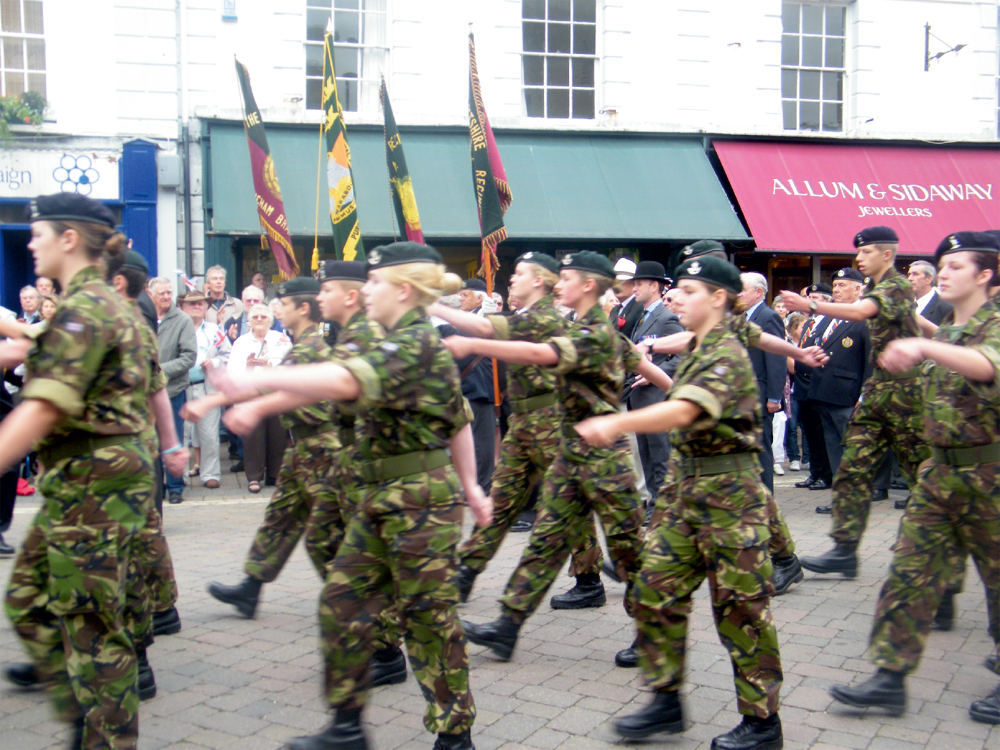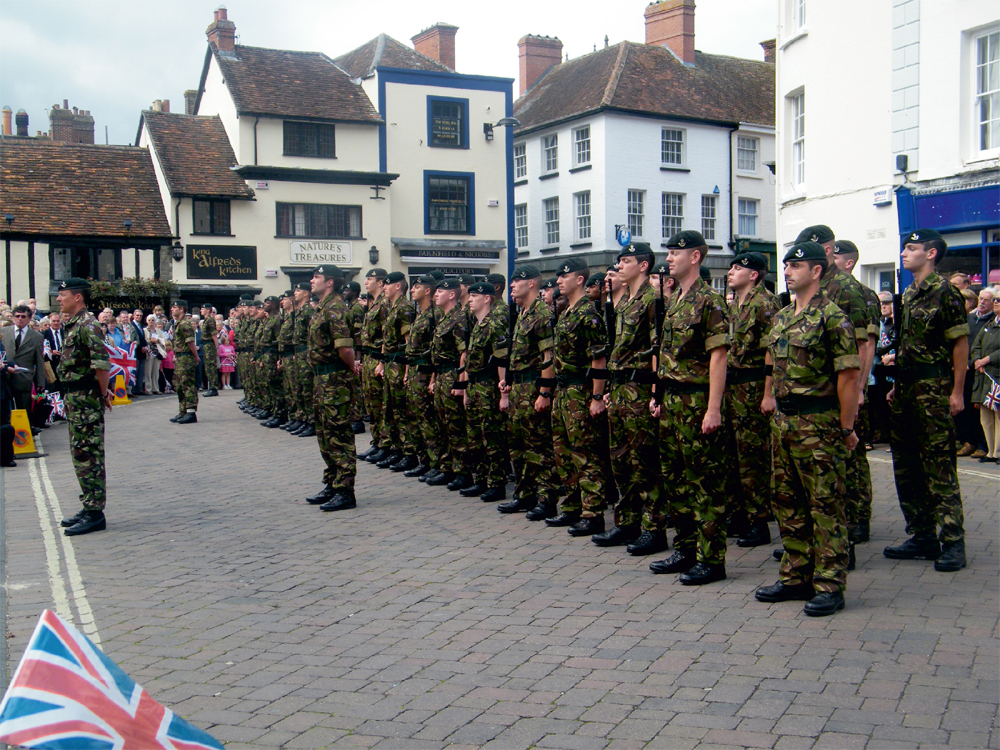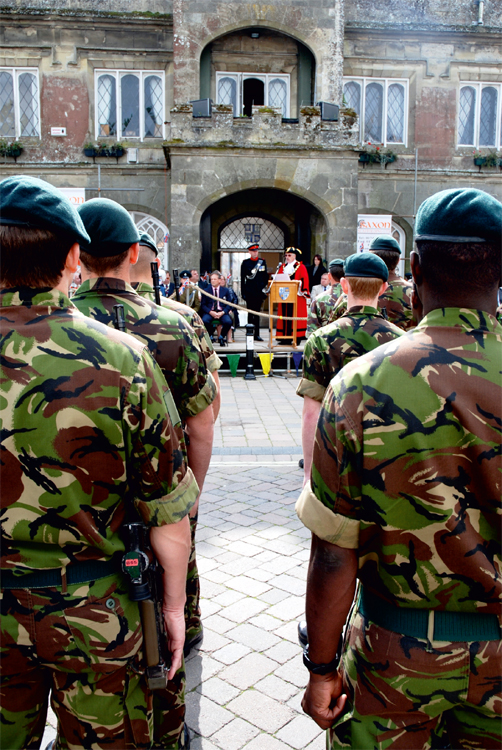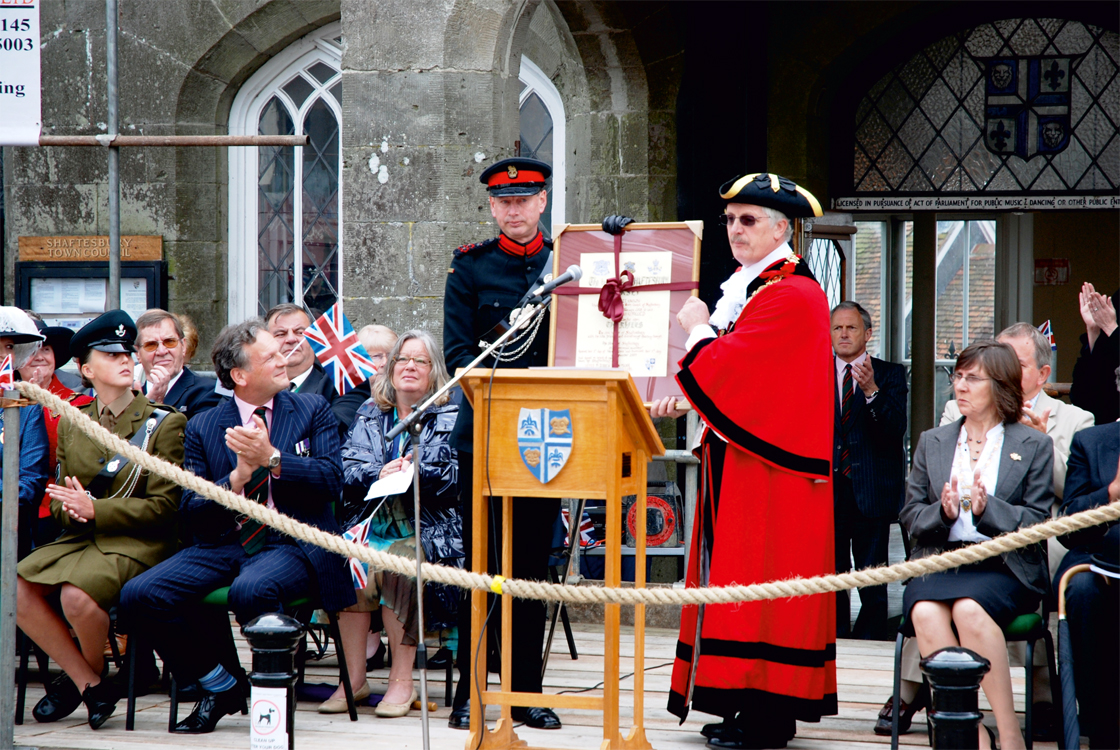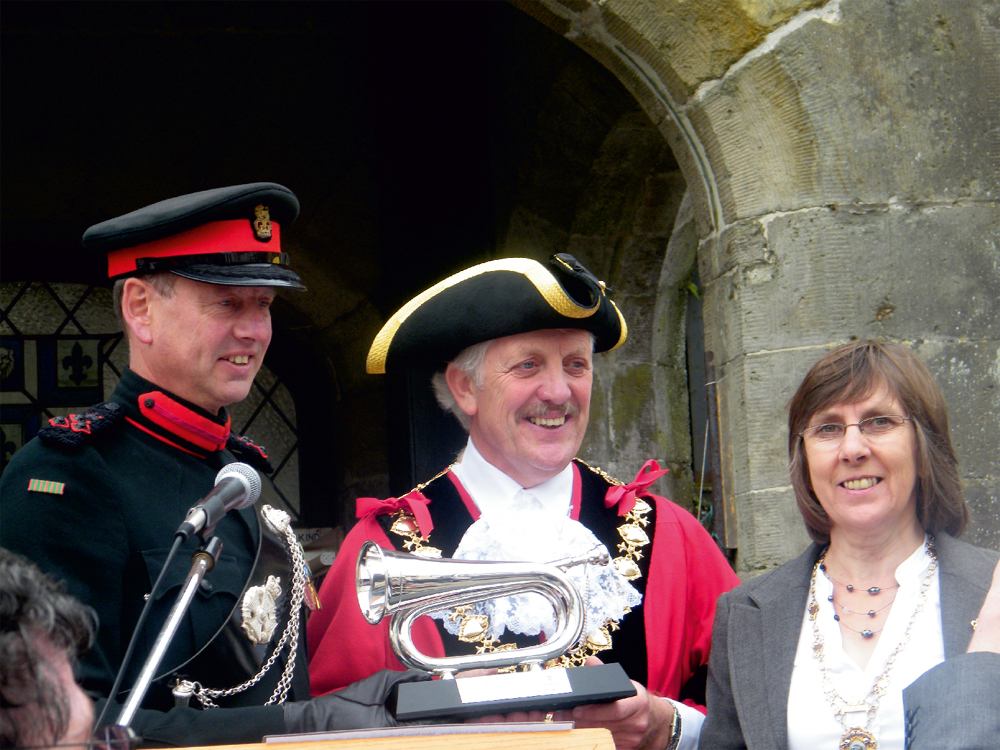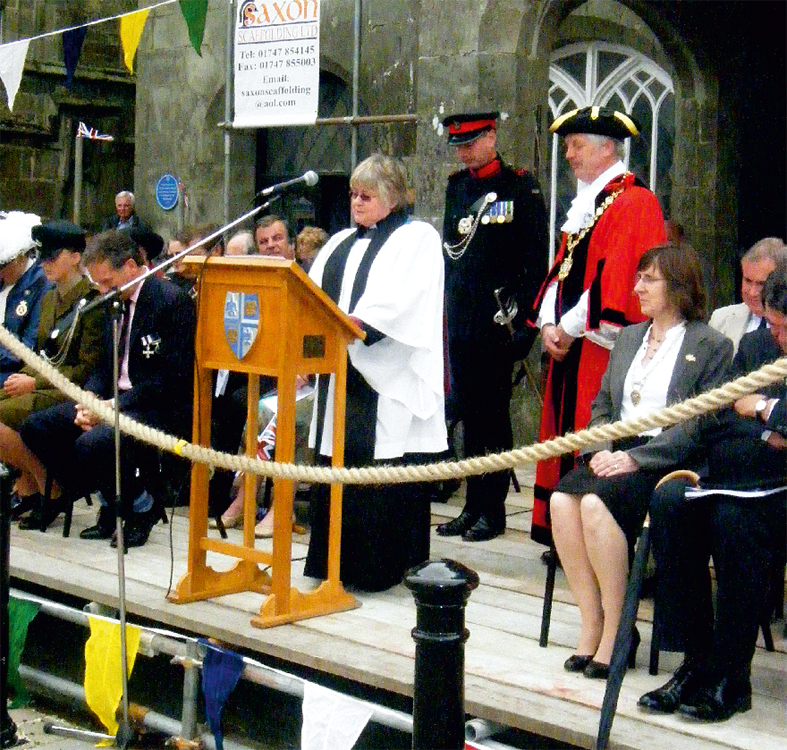THE GRANTING OF THE CIVIC HONOUR OF FREEDOM BY THE TOWN OF SHAFTESBURY TO THE RIFLES SATURDAY, 5th SEPTEMBER, 2009
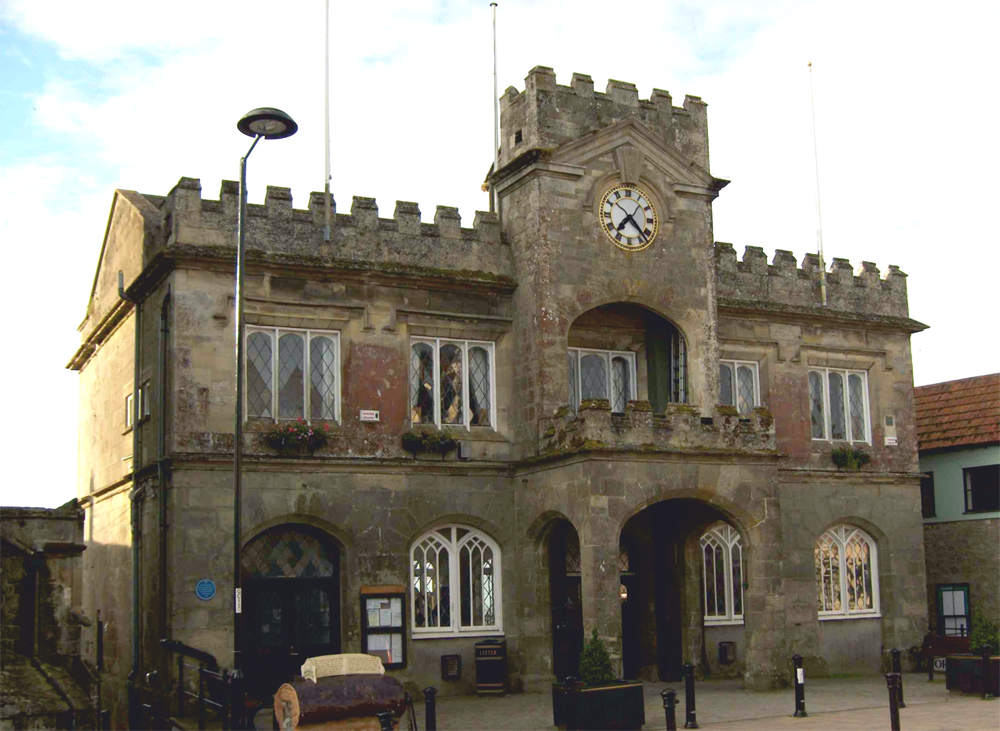
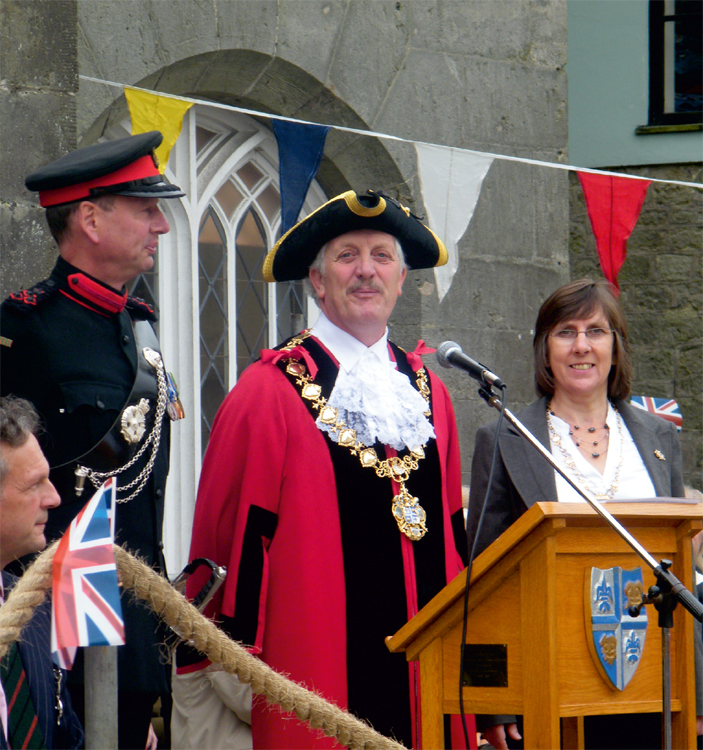
The Mayor and Mayoress of Shaftesbury Cllr Lester and Mrs Jayne Dibben 2009-10
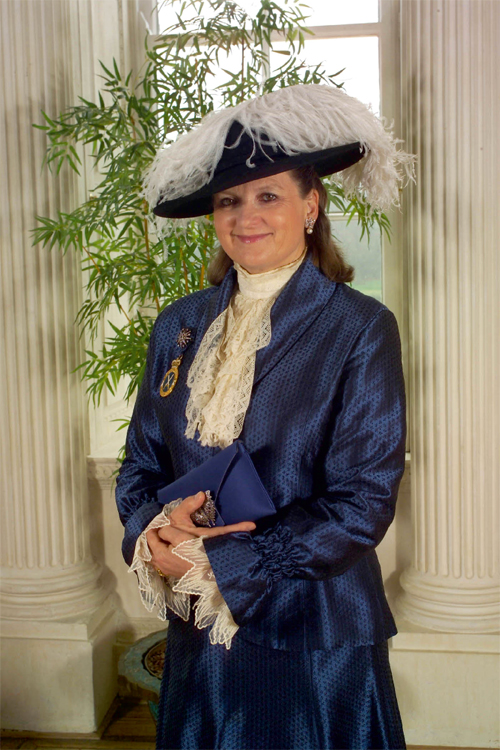
The High Sherriff of Dorset Victoria McDonaugh
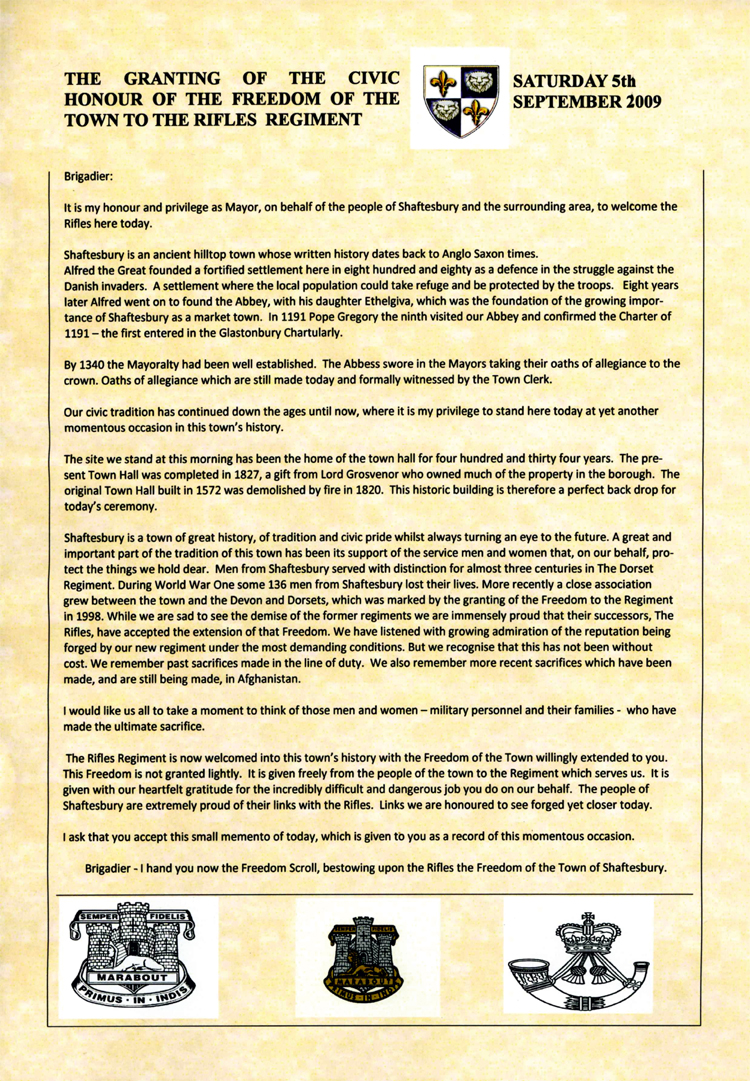
The Inspection
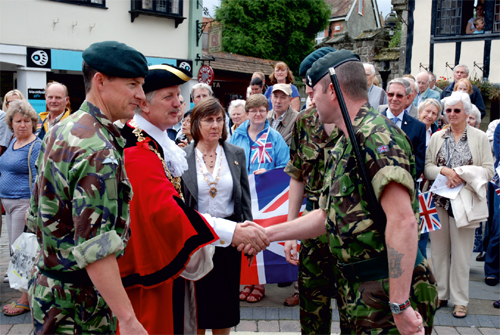
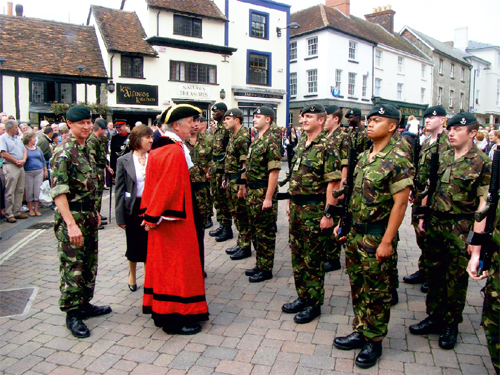
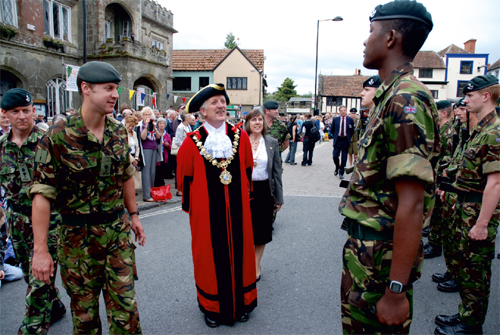
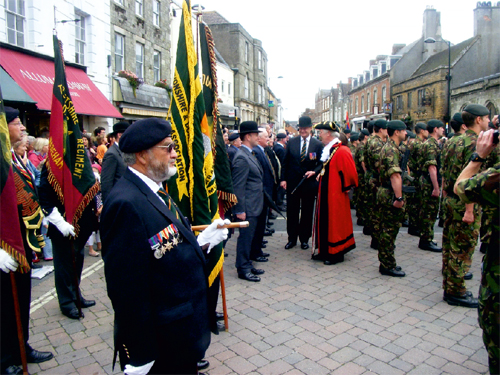
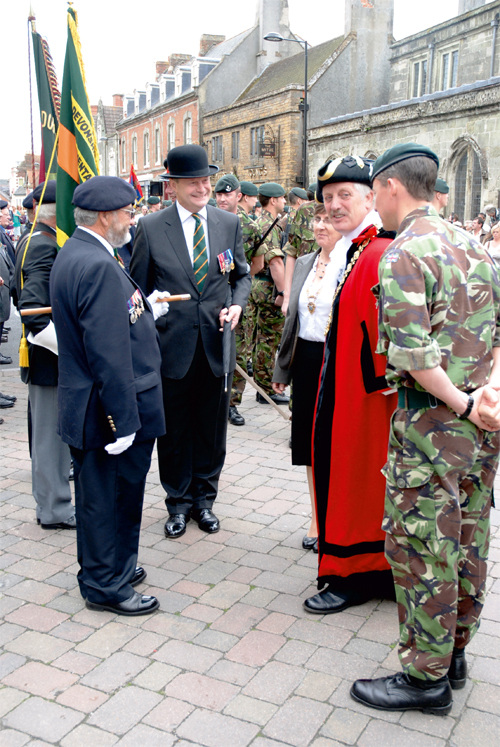
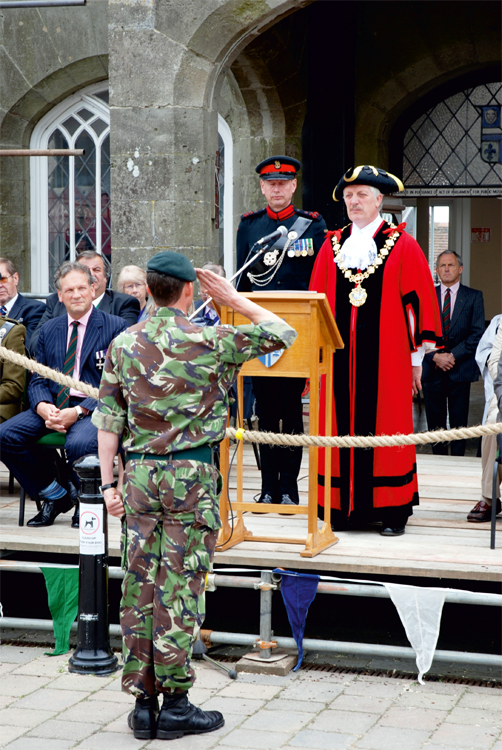
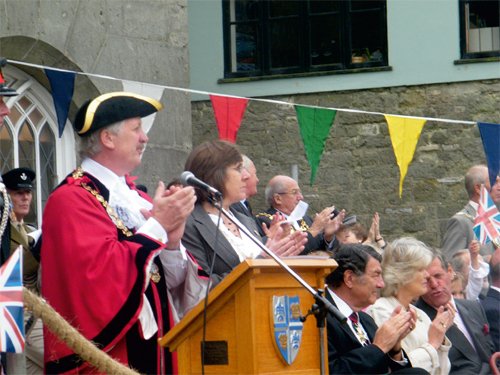



Lieutenant Colonel J M Woodhouse MBE MC
Lieutenant Colonel John Michael "Jock" Woodhouse was born in London in 1922, the only son of Brigadier Charles Woodhouse, who was Colonel of the Dorset Regiment in the 1930s. He was educated at Malvern College and was commissioned into the Dorset Regiment in 1942. As was often the case during the war, he was sent to serve with a regiment other than his own, namely the East Surreys, based in Tunisia and later, Sicily. It was while with 1 st Battalion the East Surrey Regiment that he won his Military Cross as commander of the unit's battle patrol group. Guided by two co-operative Italians, he led a night attack using grenades and explosive charges on a group of buildings occupied by tank crews of what proved to be the 16th Panzer Division. He achieved complete tactical surprise by deep penetration behind the enemy's forward positions and, after negotiating a minefield, captured a prisoner to identify the enemy formation and inflicted a number of casualties among the tank crews. In March 1944 a patrol he was leading was ambushed near Cassino. He was captured and spent the rest of the conflict as a PoW.
After the war he attended a Russian language course at Cambridge University and was employed as an interpreter in HQ BAOR before being posted to 1 Dorset in Austria, where he captained the battalion ski team. He was briefly GSO3 Intelligence HQ 40 Division in Hong Kong before, in 1950, joining the Malayan Scouts (SAS) under the command of Lieutenant Colonel Michael Calvert, a veteran of Chindit operations in Burma. He served initially as Intelligence Officer, then OC A Squadron and later Regimental Training Officer. In this latter role he returned to England to establish a selection process based on his own professional standards of self discipline and endurance. The system he developed provided the basis of selection and training for the modern SAS.
From 1953 to 1955 he was Adjutant 4 Dorset under the command of Lieutenant Colonel Joe Symonds, before returning to Malaya to command D Squadron 22 SAS. He was appointed MBE in 1957 for his services in command of his Squadron. It was around this time that someone remarked, "With Woodhouse you just had to be on top of your job. God knows what would have happened if you weren't because
no one ever took a chance on it."
In 1958, he married Peggy Lacey (who sadly predeceased him) and in the same year transferred from the Dorset Regiment to the Parachute Regiment, commanding a company in the 3rd Battalion for a year before being appointed second-in-command of 22 SAS. In 1962 he was chosen to command the Regiment and that December the Brunei revolt erupted and was followed by President Sukarno's confrontation with the new Federation of Malaysia. This initially took the form of incursions across the land border into the former British territories of Sarawak and North Borneo. At that time, the SAS was being considered for contingency operations in Europe in the event of any Warsaw Pact attack, but Woodhouse had anticipated problems in South-East Asia, albeit in the form of communist subversion rather than the nationalist aggression instigated by Sukarno. The Brunei revolt was speedily dealt with but once the Indonesian threat became clear, he called on the Director of Military Operations in the MoD and offered the services of 22 SAS. The suggestion was accepted by Major General Walter Walker, Director of Operations in East Malaysia. In the period before cross-border intelligence gathering and ambushing began, SAS four-man teams sited themselves close to the geological fault lines of the border mountain range and, as they had done with the aborigines of northern Malaya in the previous decade, organised the jungle tribes to be their eyes and ears for Indonesian intentions.
In January 1964 Woodhouse launched one of his squadrons on Operation Claret - cross-border patrols to locate camps, close to the frontier, from which Indonesian incursions were launched, and their routes into Sarawak. He determinedly applied a policy of "shoot and scoot" developed during his earlier experiences in Italy, convincing his SAS troopers that intelligence was of more long-term value than a few dead Indonesians. Commonwealth forces brought the Indonesian incursions to an end in 1965 and 22 SAS was withdrawn. When Colonel David Stirling, founder of the Special Air Service, opened the Regiment's headquarters in Hereford, he acknowledged five co-founders including, in his words, "John Woodhouse, who created the modem SAS during the Malayan campaign by restoring to the regiment its original philosophy". Woodhouse had not served in the wartime SAS, but his grasp of how men should be selected, trained and directed for special force operations places him close in repute to Stirling himself. Woodhouse retired to civilian life in 1965. He worked for three years as a security consultant to the Foreign and Commonwealth Office until joining Hall & Woodhouse Brewery in Blandford as the managing director of its soft drinks division, later known as Panda Drinks. He was also involved in local forestry management.
Lt Col Woodhouse MBE MC died on 15th February 2008, aged 85.
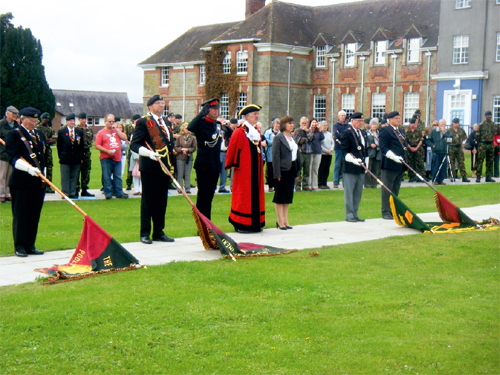
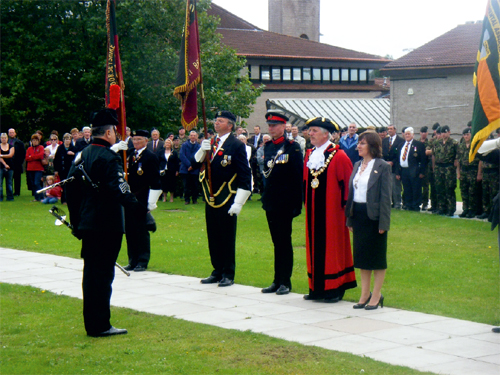
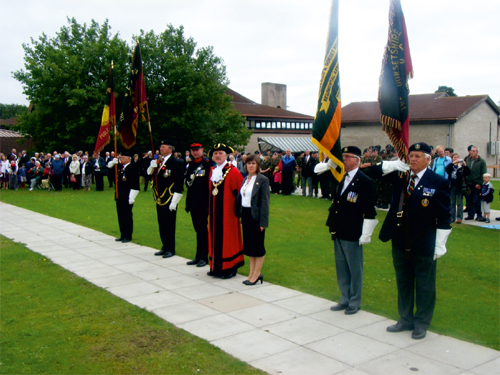

Rifleman Phillip Jonathan Allen, 2nd Battalion, The Rifles, 6 February 1989 - 7 November 2009
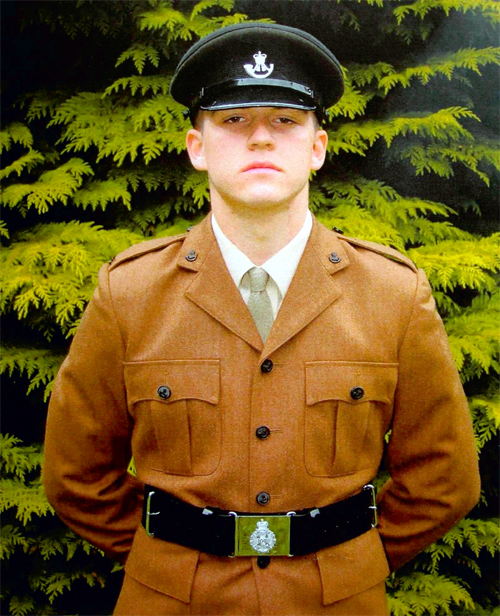
To My Son
My dear Son, although I cannot see you,
Through this screen,
I know you are really there.
I bring you into reality,
Like magic in the air.
Your voice is like an angel,
Though I really do not hear.
Your hugs as warm as any,
Of the loved ones I hold dear.
You are always there for comfort,
Or with words of cheer.
Though you are far away,
I will always have you near.
You are a very special son and friend,
Like none I have ever known.
As long as you are in my heart
I'll never be alone.
The Final Inspection
The soldier stood and faced God,
Which must always come to pass.
He hoped his shoes were shining,
Just as brightly as his brass.
"Step forward now, you soldier,
How shall I deal with you?
Have you always turned the other cheek?
To my Church have you been true?"
The soldier squared his soldiers and said,
"No, Lord, I guess I ain't.
Because those of us who carry guns,
Can't always be a saint.
I've had to work most Sundays,
And at times my talk was tough.
And sometimes I've been violent,
Because the world is awfully rough.
But, I never took a penny,
That wasn't mine to keep...
Though I worked a lot of overtime,
When the bills just got too steep.
And I never passed a cry for help,
Though at times I shook with fear.
And sometimes, God, forgive me,
I've wept unmanly tears.
I know I don't deserve a place,
Among the people here.
They never wanted me around,
Except to calm their fears.
If you've a place for me here, Lord,
It needn't be so grand.
I never expected or had too much,
But if you don't, I'll understand."
There was a silence all around the throne,
Where the saints had often trod.
As the soldier waited quietly,
For the judgement of his God.
"Step forward now, you soldier,
You've borne your burdens well.
Walk peacefully on Heaven's streets,
You've done your time in Hell.”
THE BONES OF KING EDWARD, KING OF ENGLAND AD 975-978
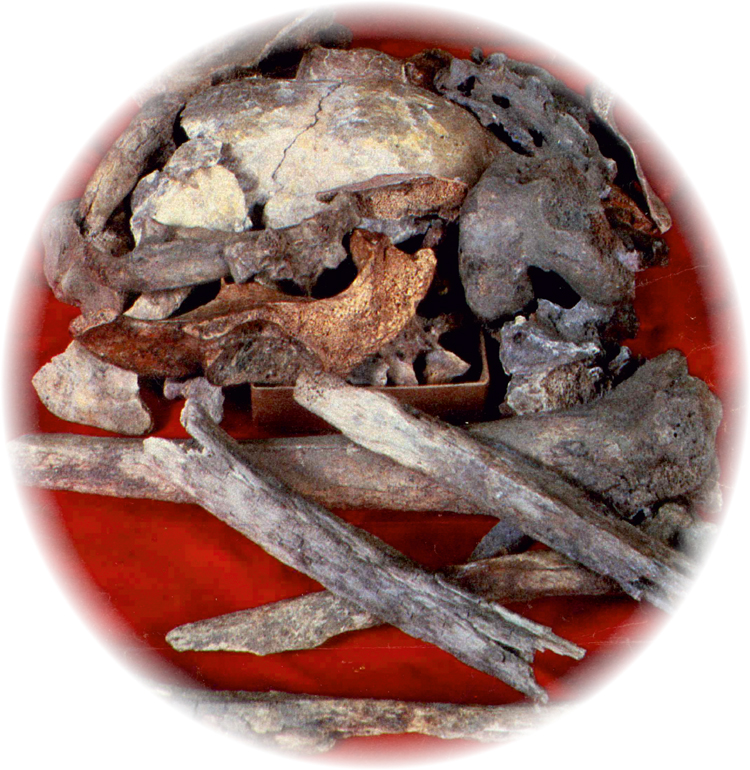
Once buried at Shaftesbury Abbey ......
Extract from Sunday Express Magazine, August 1986
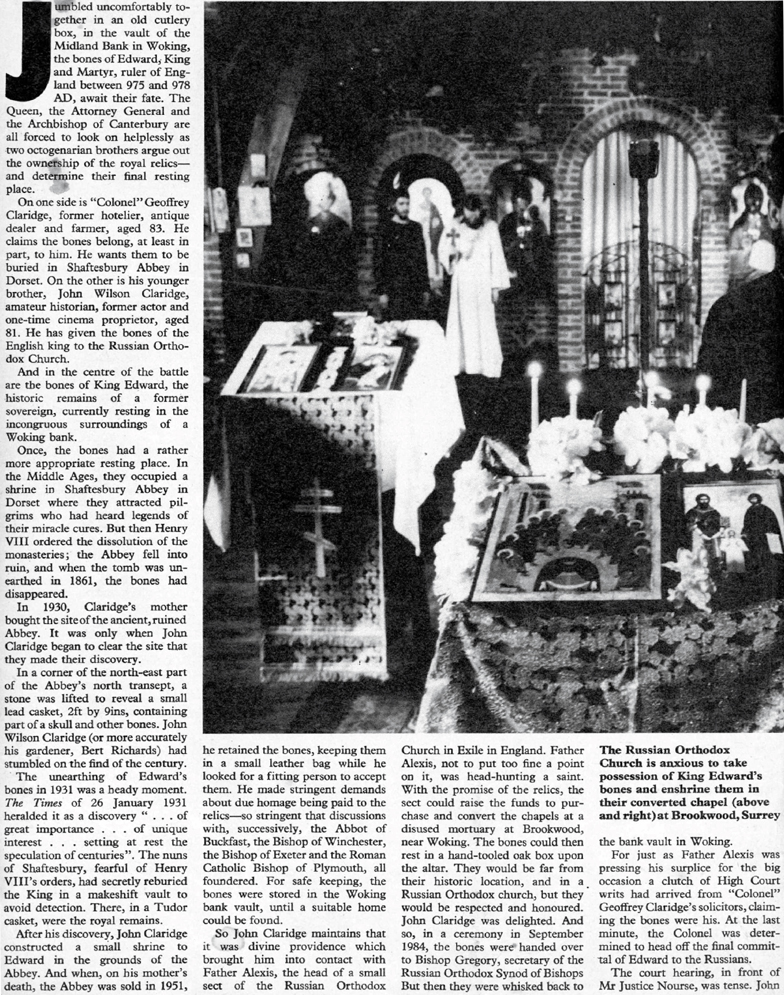
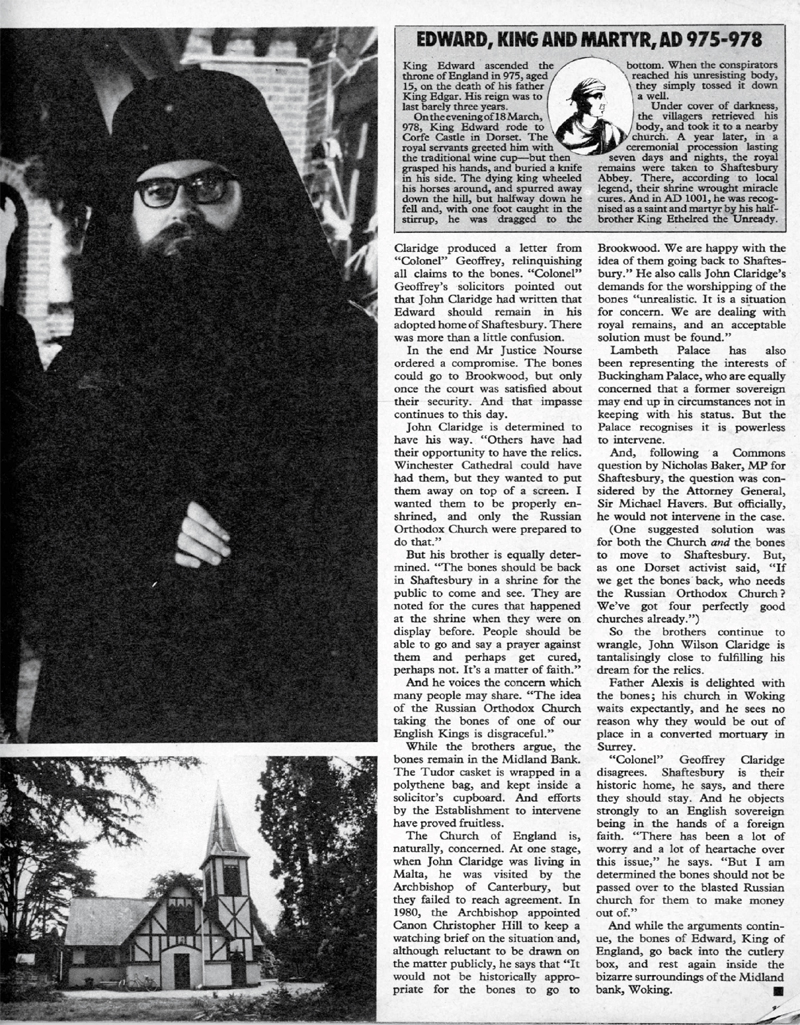
HISTORY
EXTRACT ONE
Although Shaftesbury's recorded history dates from Anglo-Saxon times, it may have been the Celtic Caer Palladur (Caer Vynnydd y Paladris). Its first written record as a town is in the Burghal Hidage. Alfred the Great founded a Burgh (fortified settlement) here in 880 as a defence in the struggle with the Danish invaders. Alfred and his daughter Ethelgiva founded Shaftesbury Abbey in 888, which was a spur to the growing importance of the town. Athelstan founded three royal mints, which struck pennies bearing the town's name, and the abbey became the wealthiest Benedictine nunnery in England.
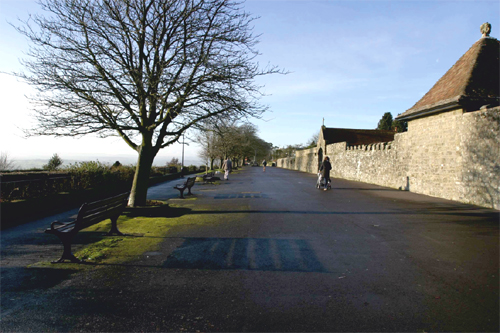
On February 20th 981 the relics of St Edward the Martyr were translated from Wareham and received at the Abbey with great ceremony, thereafter turning Shaftesbury into a major site of pilgrimage for miracles of healing.
King Canute died here in 1035. In the Domesday Book, the town was known as Scaepterbyrg; its ownership was equally shared between King and Abbey. The Abbey was in the Middle Ages the central focus of the town.
In 1260, a charter to hold a market was granted. In 1392, Richard II confirmed a grant of two markets on different days. By 1340, the mayor had become a recognised figure, sworn in by the Steward of the Abbess. In 1539, the last Abbess of Shaftesbury, Elizabeth Zouche, signed a deed of surrender, the (by then extremely wealthy) abbey was demolished, and its lands sold, leading to a temporary decline in the town. Sir Thomas Arundel of Wardour purchased the abbey and much of the town in 1540, but when he was later exiled for treason his lands were forfeit, and the lands passed to Pembroke then Anthony Ashley Cooper, 7th Earl of Shaftesbury, and finally to the Grosvenors.
EXTRACT TWO
Shaftesbury was a parliamentary constituency returning two members from 1296 to the Reform Act of 1832, when it was reduced to one, and in 1884 the separate constituency was abolished. The town was broadly Parliamentarian in the Civil War, but was in Royalist hands. Wardour Castle fell to Parliamentary forces in 1643; Parliamentary forces surrounded the town in August 1645, when it was a centre of local Clubmen activity. The clubmen were arrested and sent to trial in Sherborne. Shaftesbury took no part in the Monmouth Rebellion of 1685.
The town hall was built in 1827 by Earl Grosvenor after the Guildhall was pulled down to widen the high street.It has been designated by English Heritage as a grade II listed building.[2] The town hall is next to the 15th century St Peters church.[3]
The major employers in the 18th and 19th centuries were buttonmaking and weaving. The former became a victim of mechanisation, and this caused unemployment and emigration.
The five turnpikes which met at Shaftesbury ensured that the town had a good coaching trade. The railways, however, bypassed Shaftesbury, and this influenced the subsequent pattern of its growth.
In 1919, Lord Stalbridge sold a large portion of the town, which was purchased by a syndicate and auctioned piece by piece over three days.
Most of the Saxon and Medieval buildings have now been ruined, with most of the town dating from the 18th century to present. Thomas Hardy wrote: “Vague imaginings of its castle, its three mints, its magnificent apsidal Abbey, the chief glory of south Wessex, its twelve churches, its shrines, chantries, hospitals, its gabled freestone mansions—all now ruthlessly swept away—throw the visitor, even against his will, into a pensive melancholy, which the stimulating atmosphere and limitless landscape around him can scarcely dispel.”
EXTRACT THREE
Charles II was an easy-going man, and is known in history as the "Merry Monarch", with religious toleration dominating the political scene during his reign.
The king had numerous mistresses and illegitimate children, and loved racing and gambling which this led to him having a considerable influence on Restoration art and literature.
He spent part of the English Civil War as Prince of Wales fighting on his father's behalf (King Charles I) in the West of England. Charles's foreign policy was a wavering balance of alliances with France and the Dutch and his reign also saw the rise of colonisation and trade in India, the East Indies and America, and the passage of Navigation Acts that secured Britain's future as a sea-power.
His desire to become an absolute monarch caused him to favour Catholicism for his subjects as most consistent with absolute monarchy, converting from a Protestant to a Catholic on his deathbed.
His reign was also distinguished by occurrence of the plague, the great fire of London and the passing of the Habeas Corpus Act, one of the great bulwarks of English liberty next to the Magna Charta.
EXTRACT FOUR
Castle Hill can be spectacular. "An ancient Saxon hilltop town", claims the sign as you enter Shaftesbury, though it may be that the town's history extends much further into the past. Tradition says that the town may have been known as Caer Palladur in Celtic times. Shaftesbury's first recorded appearance as a town is in a document known as the 'Burgal Hideage'. King Alfred knew a strategic site when he saw one and so it was here that in the 9th century he created a burgh, or fortified settlement, as a defense against the encroachment of the Danes.
Alfred also founded an abbey for his daughter, Ethelgiva in AD 880, who became its first abbess. The foundation of the Abbey led to prosperity for the town, and Athelstan authorised a royal mint which struck silver pennies bearing the name of the town. and this became the wealthiest Benedictine nunnery in England. The remains of King Edward the Martyr, (reputedly murdered by his stepmother at Corfe Castle near Wareham), were interred here in 979 and later King Canute died here, although he is buried at Winchester.
By 1086/7 when the Domesday book was being compiled, the town was known as Sceapterbyrg, and owned half by the King and half by the Abbey. It is recorded that there were 66 houses in the King's lordship and 111 in that of the Abbess. The three moneyers were each paid 1 silver mark and 20 shillings whenever the coinage was changed. Shaftesbury was the only Borough in Dorset to have three moneyes. Dorchester and Wareham had two and Bridport one.
For much of the medieval period the town was dominated by the Abbey and its fortunes closely linked with it. The shrine of St Edward drew many pilgrims, and a badge, probably worn by one as a memento of the visit can be seen in the local history museum. In 1240, Cardinal Otto, legate to the Apostolic See of Pope Gregory IX visited the abbey and confirmed a charter of 1191, the first entered in the Glastonbury chartulary. In 1260 is noted the first emergence of the town as a commercial centre with the granting of a charter to hold a market. In medieval times the trade of the town was carried out at fairs and markets, the abbey and the King levying
tolls on wagons and produce. By 1350 the Mayor is a recognised figure, though still being sworn in by the Steward of the Abbess. In 1392 Richard II confirmed a grant of two markets in the town, on Mondays and Saturdays. The Borough Mace, which is still in use, was first recorded in 1475. Shaftesbury and the surrounding district were represented in Parliament by two members from 1296 until 1832, then with the Great Reform Bill, by only one until 1884, when it merged with the County Constituency. The Abbess and nuns of Shaftesbury added to the wealth of the Abbey estates. Many were well connected to the great families of the times and the Abbey was a great landowner. However, all this came to an abrupt end in 1539, with the signing of the deed of surrender by Elizabeth Zouche to the king, Henry VIII. Within a very short space of time 600 years of history had been wiped out. The nuns were dispersed, the abbey church demolished and the lands sold.
Sir Thomas Arundel of Wardour purchased the abbey site and much of the town in 1540. He was later executed for treason and his estates forfeited. The lordship of the town passed through various hands, from the Arundels to Pembroke, then Cooper and finally the Grosvenors. Deprived of custom from pilgrims to the abbey the town suffered a decline. The Mayor and Burgesses were only a corporation by prescription, and at an inquisition taken at Sturminster in 1583 they were unable to prove their rights as an officially incorporated body. The market tolls and dues were escheated to Queen Elizabeth who granted them by letters patent to private persons. It took nearly a century of lengthy litigation for the town to recover its dues and status. The 'new guildhall', a small building set on arches, was in the middle of the High Street near St. Peter's church. It was pulled down in 1822 in order to widen the highway, the present Town Hall being built in 1827 and given to the town by Earl Grosvenor. A charter of 1604 granted by James I made the town a free borough with a common seal, and it is here that records note the appearance of a second mace. This charter, together with one of Charles II dated 1665, is to be seen in the town hall. Records seem to show that the town was in sympathy with Parliament during the period of the Civil War. Wardour Castle fell to Parliament forces in 1643. Parliamentary forces surrounded the town in August 1645 when a meeting of Somerset, Dorset and Wiltshire Clubmen was held. Some 50 of the leaders were arrested and sent for trial at Sherborne. Shaftesbury avoided involvement in the Monmouth Rebellion of 1685, but along with many other towns had to display dismembered remains of some of the rebels as a grim warning to anyone who may have been involved.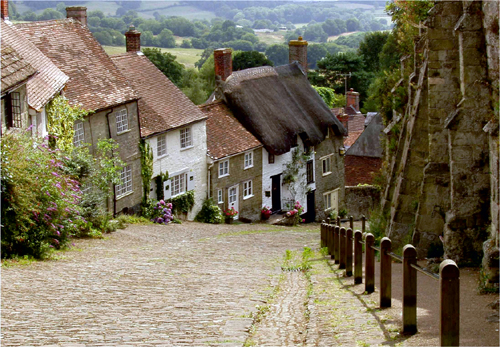
The chief industries in the eighteenth and nineteenth centuries were button making and gloving. The buttons were the best known and there were several types: a cross wheel made with brass wire and cotton and others known as Dorset Knobs, for decorative use. The display of a button making machine at the Great Exhibition in 1851 spelt doom for the local cottage industry. The decline threw many out of work and they became paupers, some emigrating to other countries. There were five turnpike roads which converged on Shaftesbury and the town had a good coaching trade. Coaches with names like 'Quicksilver' and 'The Phoenix' made regular runs. Extra horses were needed to climb Tout hill to the Red Lion, now the Grosvenor Hotel. Here can be seen a magnificent carved sideboard depicting scenes from the 'Ballad of Chevy Chase'. Carved by Gerard Robinson it was intended for one of the Dukes of Northumberland, but he died before it could be completed and it came to the Grosvenor by purchase.
The coming of the railway age put the town at some disadvantage. The nearest station in the Victorian era was at Semley; the nearest now is at Gillingham, a town some five miles to the north. The arrival of the motor car in the twentieth century has redressed the balance. One of the great events early in the century was the sale of a major part of the town by Lord Stalbridge in 1919. It was purchased en bloc by a syndicate and then re-sold over a period of three days by public auction.
Today Shaftesbury is a bustling town which is also host to one of England's most famous streets. Undoubtedly the focal point of the town for visitors is picturesque Gold Hill, a steep, thatched cottage lined cobbled street made famous by the Hovis bread adverts of a small delivery boy streaming down the hill on his bicycle. The advert's haunting melodies from Dvorak's New World Symphony roll down the steep street. This steeply cobbled street is to be found behind the Town Hall, with cottages on one side and the buttressed precinct wall of the abbey on the other. At the top of the hill is a museum containing an interesting collection of buttons, for which the town was famous. The older part of the town with its shops and historical features is situated on the headland spur. The conservation area of the town takes in much of the Saxon and Medieval areas.
Due to its height Shaftesbury offers panoramic views and bracing air. There are many sunny days when the views from Park Walk and Castle Hill can be spectacular.

The Rifles
The Rifles was formed on 1st February 2007 from an amalgamation of four famous regiments:
The Devonshire and Dorsets, the Royal Gloucestershire Berkshire and Wiltshires, the Light Infantry and the Royal Green Jackets.
The new Regiment consists of 5 Regular and 2 Territorial Battalions.
- 1st Battalion is based at Chepstow and returned from operations in Afghanistan in April.
- 2nd Battalion based in Ballykinler, Northern Ireland and deployed to Afghanistan in April.
- 3rd Battalion is based in Edinburgh and is due to deploy to Afghanistan in the end of the year.
- 4th Battalion is based in Bulford near Salisbury and deploys to Afghanistan shortly to cover the elections there.
- 5th Battalion based in Paderborn, Germany is currently returning from a tour of duty in Iraq.
- 6th (Territorial) Battalion has its Headquarters in Exeter and bases throughout the Westcountry, including Dorchester. Over 100 of the Battalion's soldiers have recently returned from Afghanistan.
- 7th (Territorial) Battalion has its Headquarters in Reading and bases throughout the Home Counties.
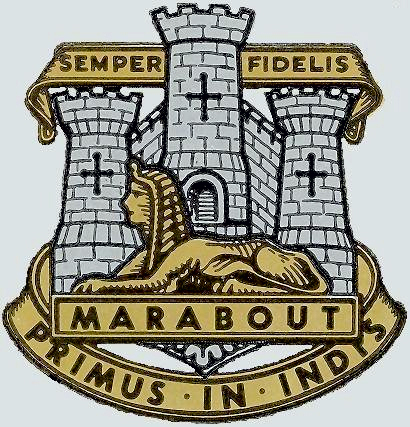
The Devonshire and Dorset Regiment
(11th , 39th and 54th Foot) (1958 – 2007)
The amalgamation of these two famous old County Regiments took place in Celle in 1958 and the presentation of its first Stand of Colours by the then Colonel-in-Chief, HRH The Duchess of Kent in Plymouth in 1962. The new cap badge embodied the Castle of Exeter and 'Semper Fidelis' from the Devons, and 'Primus in Indis' and the Sphinx with 'Marabout' from the Dorsets.
During the 1st Battalion's 49 years of existence, it has served in Germany, Cyprus, the UK, British Guiana (Guyana), Libya, Malta, British Honduras (Belize), Bosnia and Northern Ireland. Most of this service, including ten tours to Northern Ireland, two of which as a Resident Battalion, have been active service of one kind or another, the latest of which was to Iraq in 2006. The role in Germany for much of this time was that of a NATO Mechanised Battalion in 1 (BR) Corps, however since 1991 this changed to an Armoured Infantry (Warrior) role in 1 (UK) Armoured Division, part of NATO's Allied Rapid Reaction Corps. During this time the 1st Battalion has trained in Kenya, Canada, Sicily, Italy, France and in 1994 in Poland where they were the first British troops to exercise on Polish soil since before the Second World War.
The Regiment's Territorial Army Battalion, the 4th Battalion, was reformed in 1987, 20 years after disbandment of the old County TA battalions in 1967. The battalion inherited the title 'The 1st Rifle Volunteers' marking the formation of the Exeter and South Devon Rifle Volunteers in 1852, the first ever Volunteer Battalion. The 4th Battalion whose Headquarters was in Exeter, had Rifle Companies in Plymouth, Dorchester and Poole, and Headquarter Company and Support Group in Exeter before being disbanded in 1999.
The Devonshire and Dorset Regiment Chapel is in Exeter Cathedral and the Dorset Regiment Chapel is in Sherborne Abbey. The Regiment's Museum is at The Keep in Dorchester.
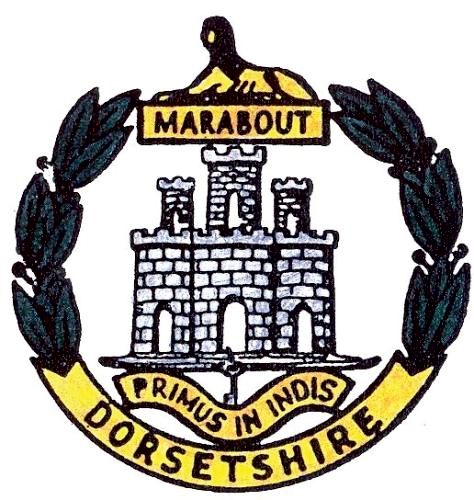
The Dorset Regiment
(39th and 54th Foot) (1702 – 1958)
The 39th Foot was raised in 1702 with several other regiments, to fight in the War of the Spanish Succession. The 54th Foot was raised in 1755. A Battle Honour unique in the British Army, Plassey (1757) was won by the 39th under Lord Clive in India, and with it the proud motto 'Primus in Indis'. Later, the 39th was one of the four British Infantry regiments to serve throughout the great siege of Gibraltar (1779 – 83), and was the only one to serve also in the previous siege of 1727. In 1801, the 54th Foot also gained a unique battle honour, Marabout, in Egypt, against Napoleon's Army. Flushed with success, they arrived at Gibraltar, in time to put down a mutiny in the garrison and so assist in saving the life of the Duke of Kent, Queen Victoria's father, who was Governor of the Fortress. Since then the House of Kent has been associated with the Regiment through the Colonels-in-Chief.
The 39th saw service in the Peninsula, particularly distinguishing themselves at Albuhera and Vittoria. During the 19th century, battle honours were won in the Crimea War (1854-56), in India and Burma, as in the South Africa War; and in the Tirah Campaign of 1897, LCpl Vickery won the VC. The epic of the SS Sarah Sands occurred when the Dorsets were en-route to India during the Mutiny of 1857; the officers and men of the regiment were primarily responsible for saving the blazing ship, filled with gunpowder, and bringing her eventually into Mauritius. A most complimentary Order was read at the head of every Regiment in the Army as a result, by order of the Commander-in-Chief.
The 39th & 54th amalgamated in 1881 under the Cardwell Reforms, to become 1st & 2nd Battalions of the Dorset Regiment. During the First World War, 10 battalions of the Dorsets served in France and Flanders, in the Gallipoli Peninsula and in the Middle East. In Mesopotamia especially, the 2nd Battalion greatly distinguished itself as did the battalions on the Western Front. In the Second World War, the 1st Dorsets served in 231 (Malta) Brigade, taking part in assault landings on Sicily, Italy and at Normandy (D Day) while the 4th (TA) Battalion, which, with the 5th, formed part of the 43rd Wessex Division, sacrificed itself in going to the rescue of the Airborne troops at Arnhem. The 2nd Battalion served in Burma, including Kohima.
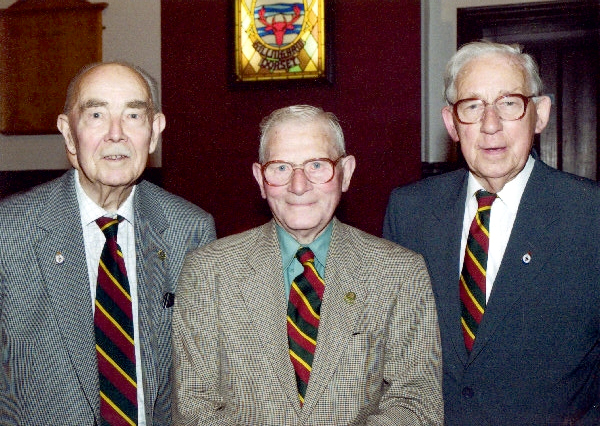
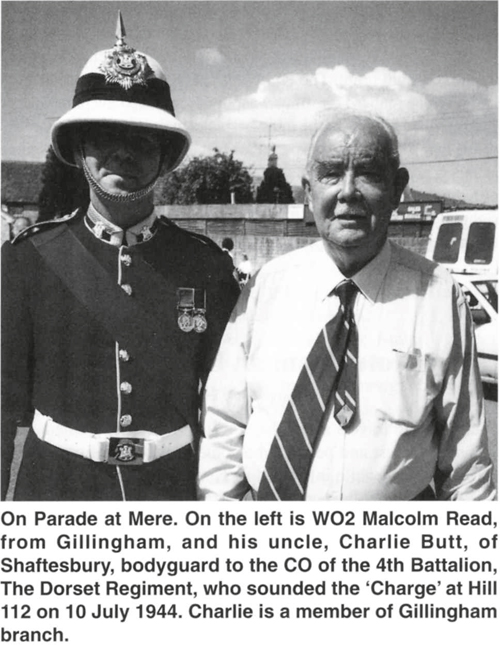
Albert’s Mission . . . .
In August 1998 I embarked on getting a World War Two tank for a memorial to the tank crews that died in one of the bloodiest battles of the conflict.
On the face of it I and everybody I have approached feel that this memorial is both extremely worthwhile and long overdue. The site of the memorial is on the notorious Hill 112, which is just South West of the Normandy town of Caen. The hill codenamed 'Jupiter' was described by the German Commander Rommel as being the most important hill in Normandy, for whoever had control of it had control of all around it. How right he was, many soldiers both Allied and Axis were to loose their lives over Hill 112.
The battle for the hill started on the night of 9/10th July 1944. My Division, the 43rd Wessex, were the main attack force gathered at the start line. We had at our disposal the support of heavy armour from the tank regiments assigned to us. The tanks, British built Churchills and American Shermans, gave us great comfort as we prepared for battle.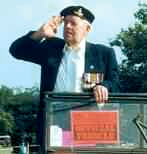
To our horror we were to find out that our supporting tanks were no match for the mighty German Tiger I. Out gunned and out armoured our tanks were turned into infernos. The Germans nicknamed the Sherman, 'Ronson' because it would go up in flames if hit, just like a Ronson lighter. In one day alone fifty Churchills were 'brewed up', with many of the crews being killed. The expression 'brewed up' was the way a soldier could sanitise, and so cope with the horrendous way many tankmen died. Many were trapped inside the hull of the tank to be consumed by fire, screaming for help in the full knowledge that no-one in the heat of battle could hear them, let alone do anything to help them. One can only begin to imagine what fear those boys, not men many were still only in their teens, must have gone through.
I served with the Royal Artillery giving supporting fire for infantry and tanks alike as they struggled to gain a foothold on the hill. During the twelve day battle my regiment 112 Field Regiment fired some 65,000 shells from twenty four guns (that's roughly 225 shells a day). Multiply that by three, 195,000 shells fired by the Divisions own three Artillery Regiments. You then have to add to that all the other heavy guns, SP's (self propelled guns) and tanks that were involved, and a picture of what it was like starts to emerge.
It is because of the sheer enormity of the battle and the terrible loss of tank crews and tanks that we of the 43rd Wessex Association wish to erect the memorial alongside our own on Hill 112. It is not just us that owe our debt of gratitude to those brave tank crews, that unstintingly and unquestioningly gave us the support we so badly needed. The local French inhabitants are just as insistent that this memorial is long overdue. There are other memorials across France but the bloody battle for Hill 112 has somehow been forgotten, which it never should have been.
Now, as the tank is unveiled on Sunday 9th June, we can continue to raise peoples awareness of today, of the sacrifices made by the 7000 casualties fifty five years ago in that twelve day battle, that has enabled us to live the way we do . . .
Free from oppression, hunger and fear.
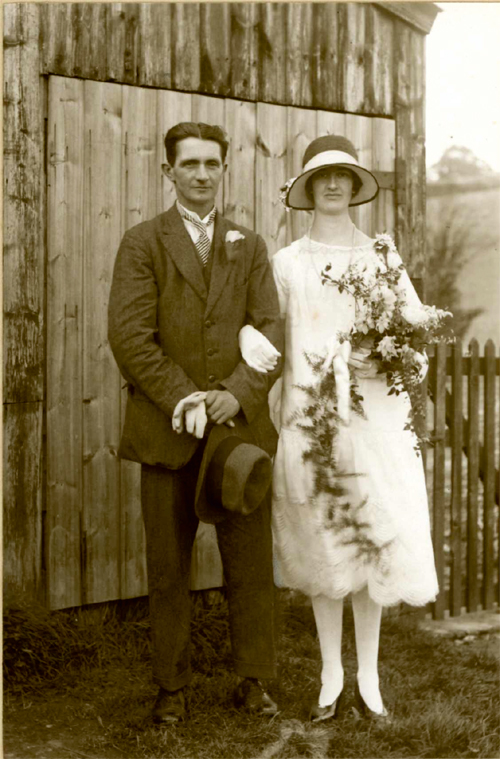
William Frederick George Head
Mayor’s Grandfather
Served in both 1st and 2nd World Wars
with the Dorset Regiment

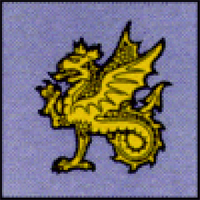
NORMANDY 1944 - HILL 112
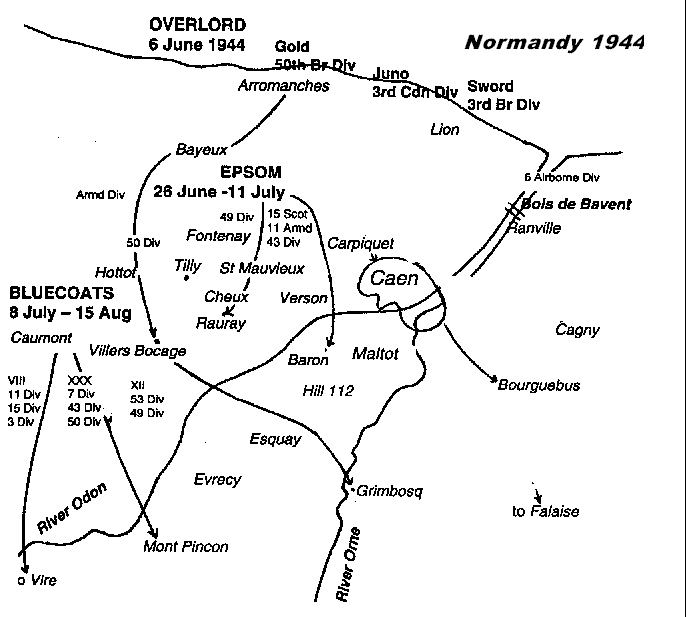
The capture of Caen and Carpiquet at the same time was followed immediately by renewed attacks west of the city in order to capture the high ground between the Odon and the Orne, to encircle Caen from the south, and above all to continue to engage the main German force so it could not block an American breakout to the south. This time the attack was on a broader front with no fewer than six divisions: the 49th and 50th attacked south to Hottot, the 59th attacked south to Noyers, the 15th Scottish was to attack Evrecy, an objective of EPSOM, followed by the 53rd, and in the first attack the 43rd Division was to capture Hill 112 and Maltot on 10 July.
The 43rd Division already held a bridgehead across the Odon, which it had taken over from the 15th Scottish and the 11th Armoured Divisions when Epsom was terminated on 30 June. Since then it had held the panzer divisions that surrounded it on three sides, though the bridgehead was less than a mile wide, consisting of little more than the banks of the Odon and including Death Valley, so called because of the casualties from mortar bombs that burst in the narrow gorge of the river with its steep slate walls.
Hill 112 was an unimpressive stretch of country covered with wheat two or three feet high, and with a few wooded copses and several villages on its slopes. From this elevation the entire valleys of the Odon and Orne could be seen, and the Germans said, "He who controls Hill 112 controls Normandy." Certainly they clung to it desperately, and when they were driven off counter-attacked at once to regain possession. Between 29 June, when the 9th and 10th SS Panzer Divisions regained the hill, and 23 July, when they were driven from Maltot, the area around Hill 112 changed hands many times and thousands of Allied and German troops were killed or wounded on its bloody slopes. The 43rd Division alone lost more than 2,000 men in the first 36 hours of operation JUPITER to regain Hill 112. It was reported that the Odon River was dammed with corpses.
The attack began before dawn on 10 July with an impressive artillery barrage. By 0630 hours 129 Brigade - 4 and 5 Wilts. and 4 Som. LI - had advanced through the waist-high wheat sprinkled with poppies. They reached their objectives at the crest of the hill, although for several hours fierce closequarter battles continued in the wheat where SS troops manned concealed machine-gun nests and refused to surrender even when wounded.
The task of 130 Brigade was to capture the villages of Eterville and Maltot, after which 214 Brigade was to exploit with an armoured brigade to the Orne. From a firm base provided by 5 Dorset, 4 Dorset launched a successful attack on Eterville, and at 0815 hours 7 R. Hamps. attacked Maltot, initiating what has been called "a battle of shattering intensity even by the standard of Normandy." SS panzer troops supported by dug-in and concealed Tiger tanks held an almost impregnable position, and even when the R. Hamps. were reinforced by 4 Dorset no progress could be made. Among the many casualties were five company commanders. From Eterville 5 Dorset and 7 SOM. LI held off savage counter-attacks, as did 5 Wilts. and 4 Som. LI during the day. By 1500 hours it was clear that a fresh attack on Hill 112 was needed, but of the 214th, the reserve brigade, two battalions had already been
committed, leaving only 5 DCLI. The CO was 26-year-old Lieutenant-Colonel James, who had been in command only 14 days, since the former CO had been killed in the first attack at Mouen on 27 June. With 4 Som. LI as a firm base 5 DCLI launched an attack at 2230 hours with two companies up. The crest of the hill was reached and the battalion consolidated in a wood, which was later called Cornwall Wood, in time to meet savage counter-attacks from the 9th SS Panzer Division. In fighting that continued all night, 10 counter-attacks were beaten off, but when Lieutenant Colonel James was killed and most of the officers and NCO's killed or wounded, the remnants of the battalion withdrew. The CO of 4 Som. LI formed the survivors into two companies and sent them back to the wood for what has been called "the death struggle of 5 DCLI," The final overwhelming attack left about 75 survivors, approximately 10 percent of the original strength of the battalion.
After the battle, all battalions of the 43rd Division required reinforcements, which, in effect, produced new battalions. Within two weeks 5 DCLI was back at full strength and in action on Hill 112, and 4 Som. LI required reinforcements of 19 officers and 479 other ranks. The enemy suffered equally. The next year when there was an opportunity to compare notes with the 9th SS Panzer Division, it was revealed that in the battle for Hill 112 casualties reduced their strength to five or six per company. It is appropriate that the 43rd Division's memorial is at Hill 112, the object of so much bloodshed in the Normandy campaign. On 29 July when Maltot was captured at last by 4 and 5 Wilts., the dead of the Dorset and R. Hamps. who had fallen on 10 July still lay in heaps around partly dug slit trenches and in streets and fields.
Extracted from 'Code Word CANLOAN' by Wilfred I. Smith.


The Following Pages are extracts from the above book by Patrick Delaforce
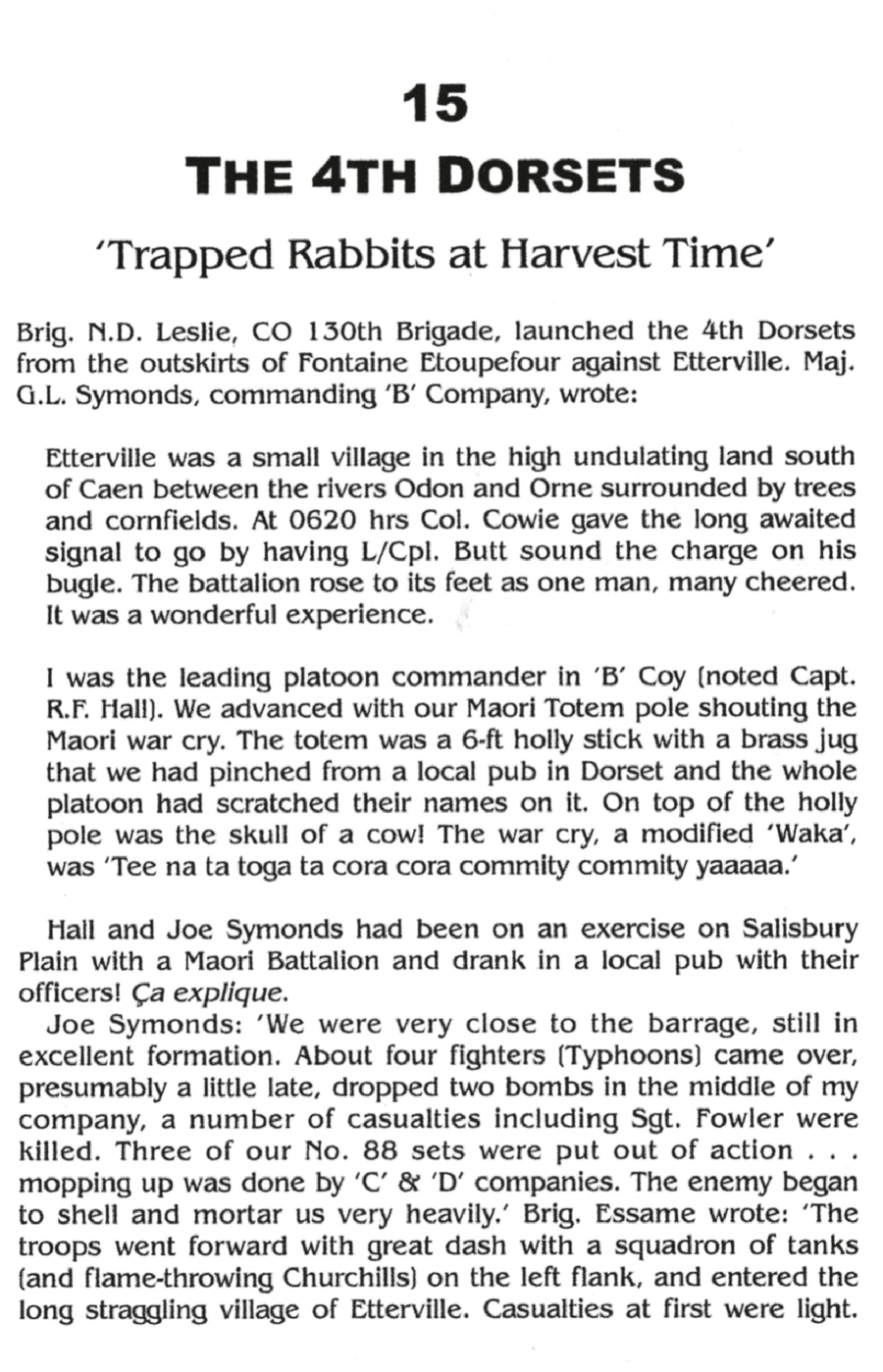
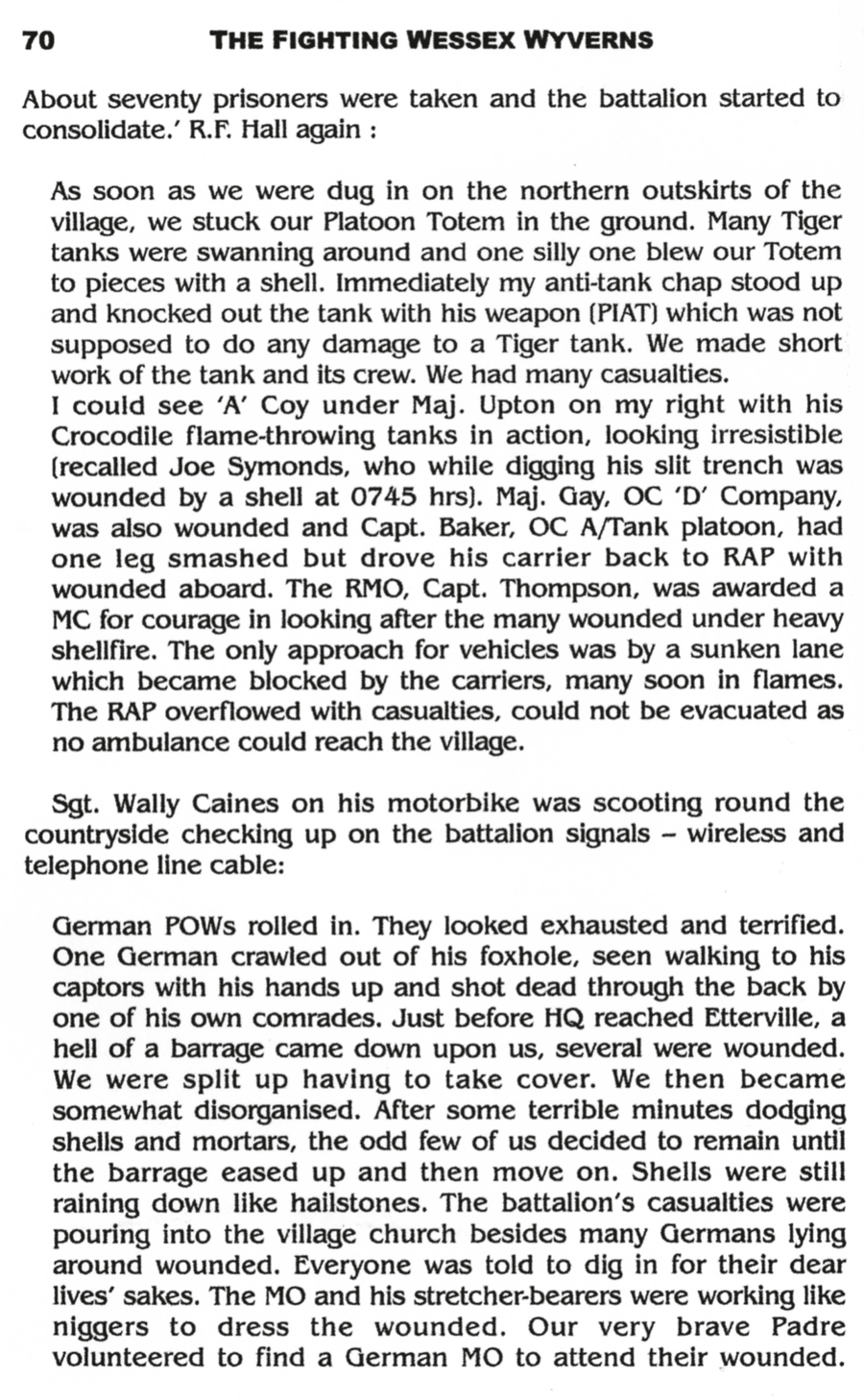
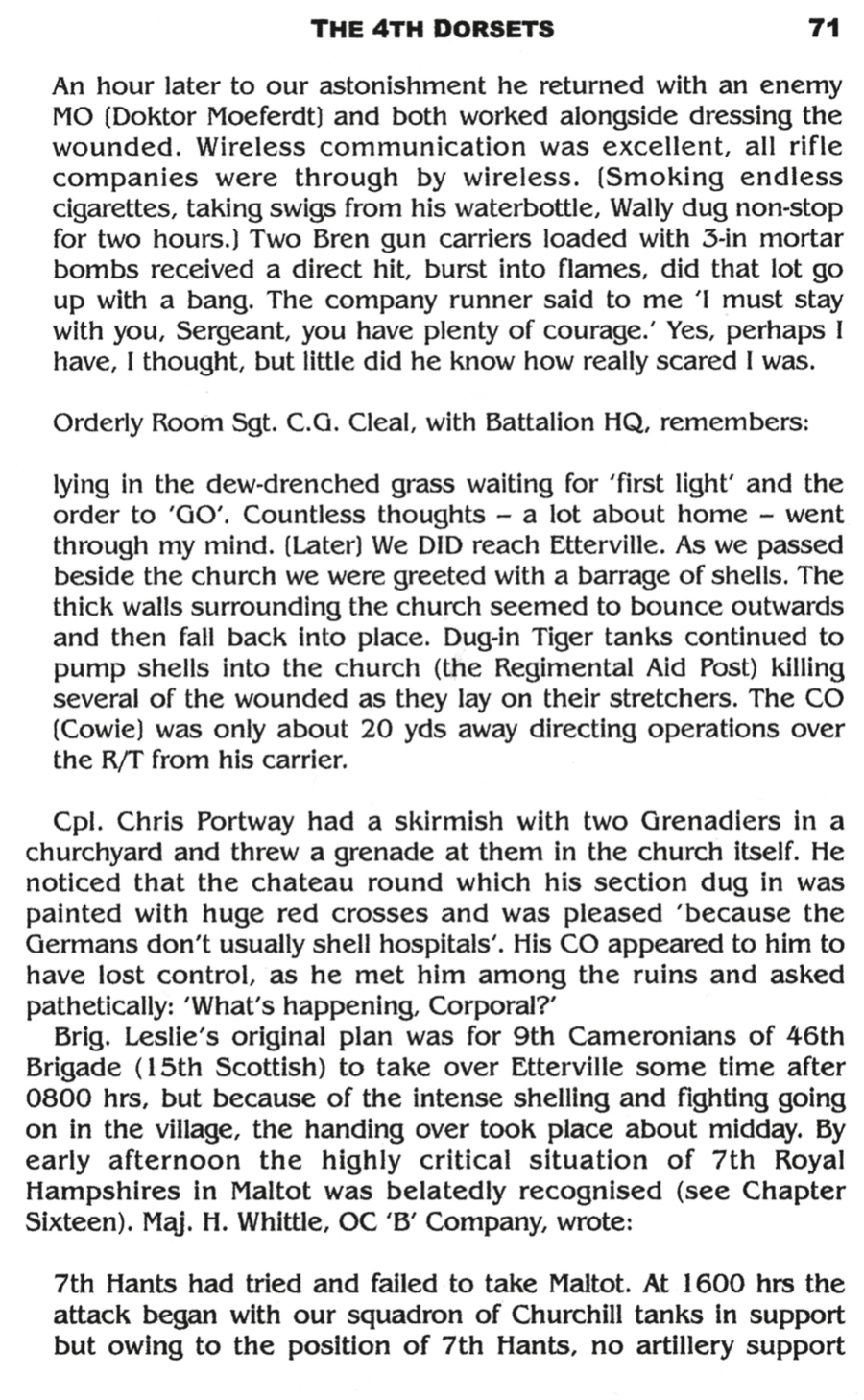
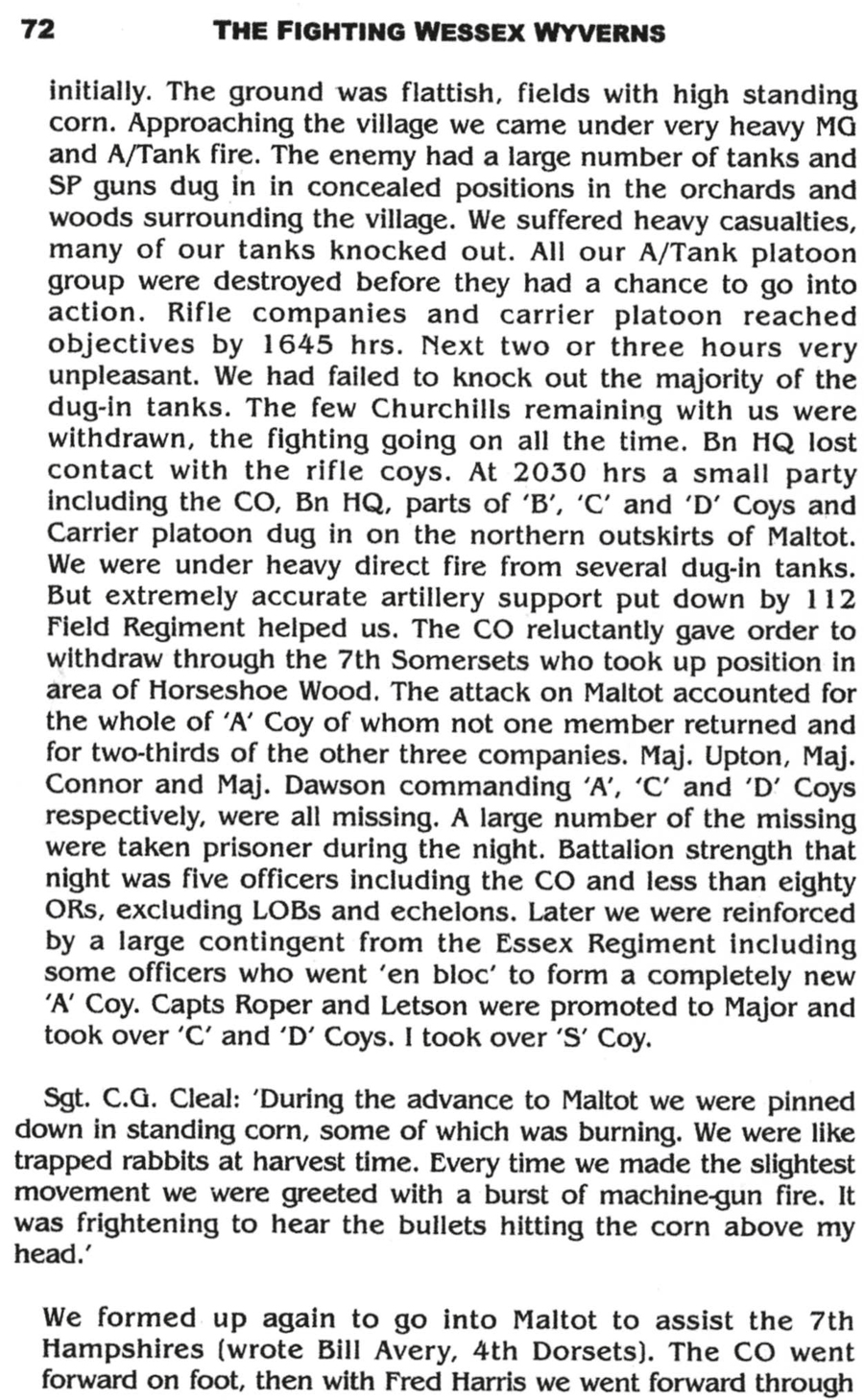
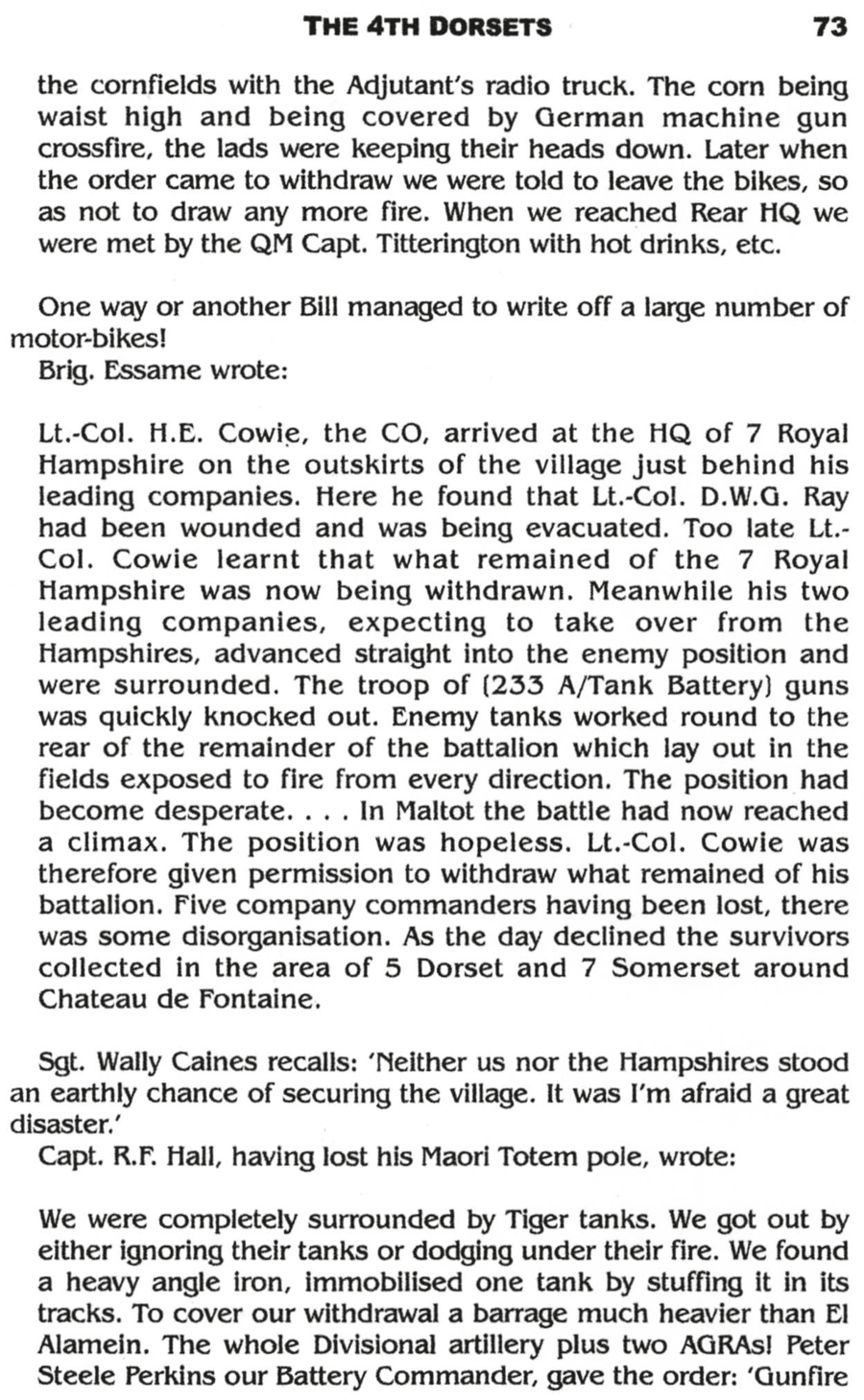
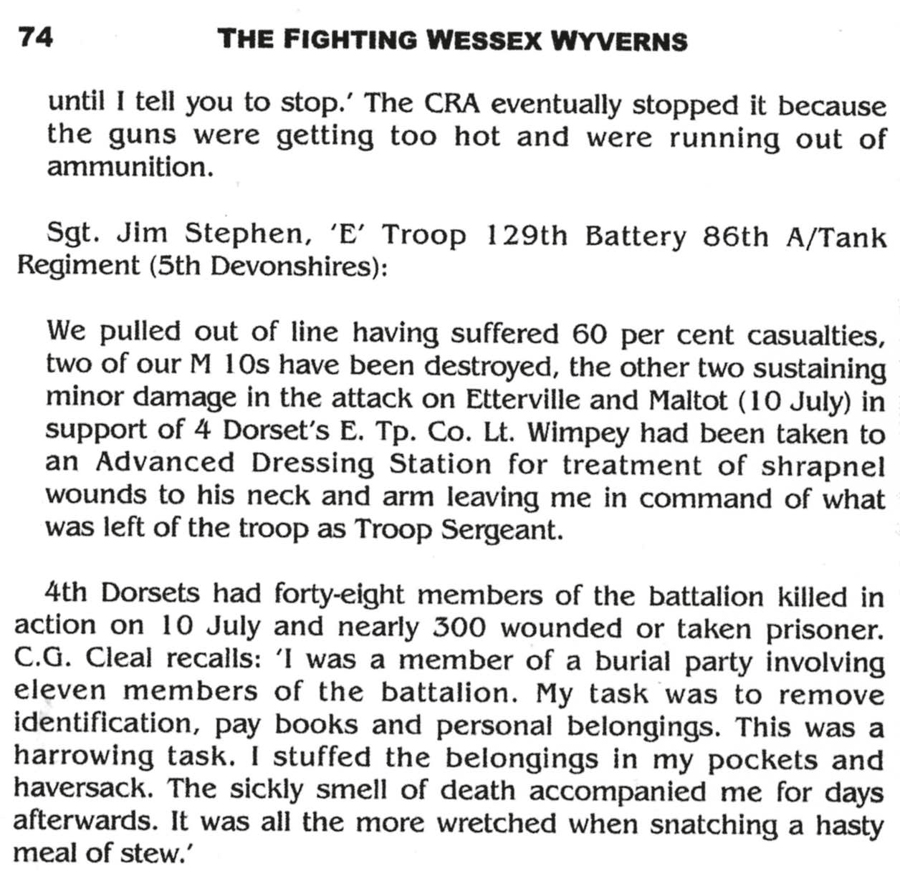
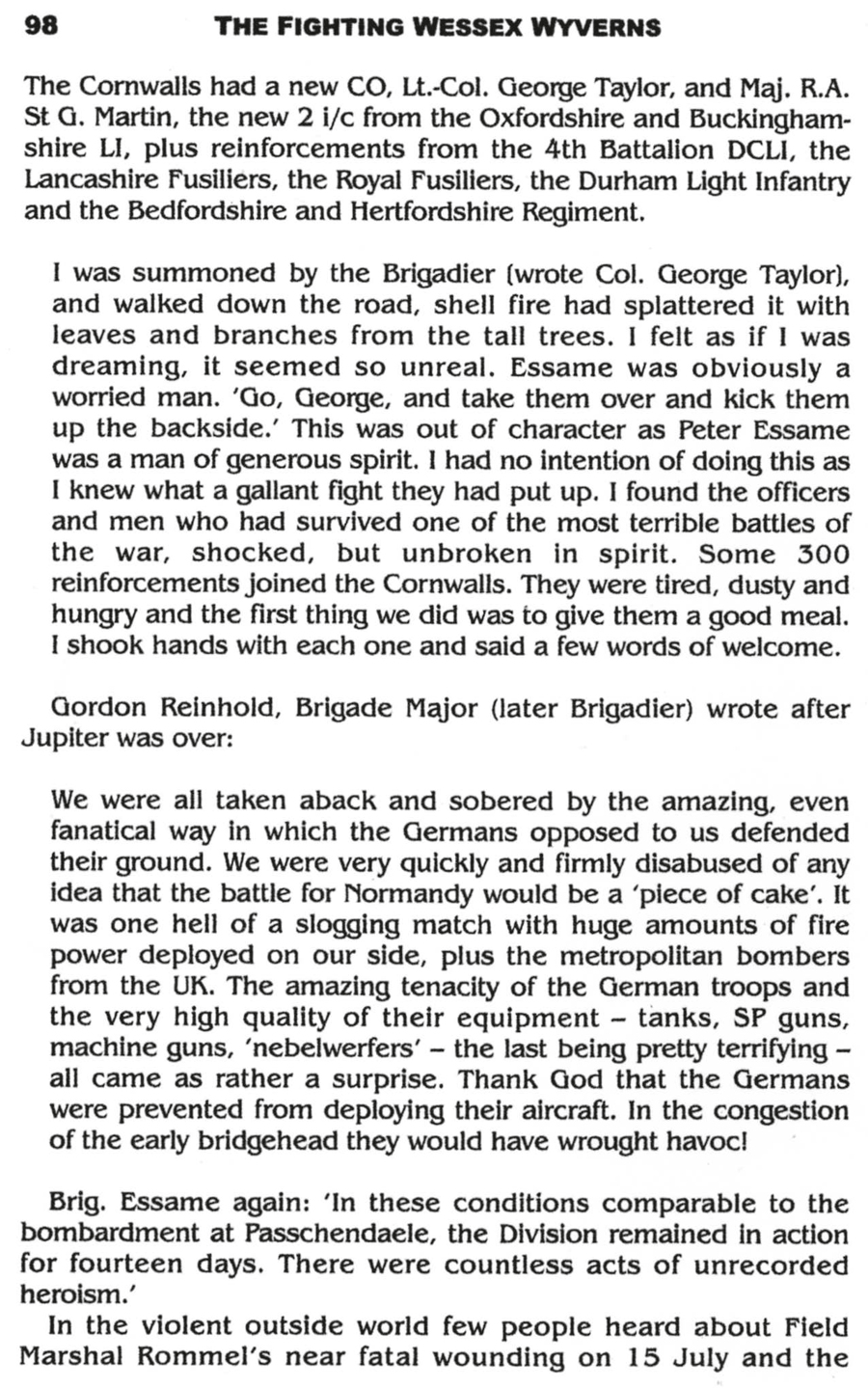
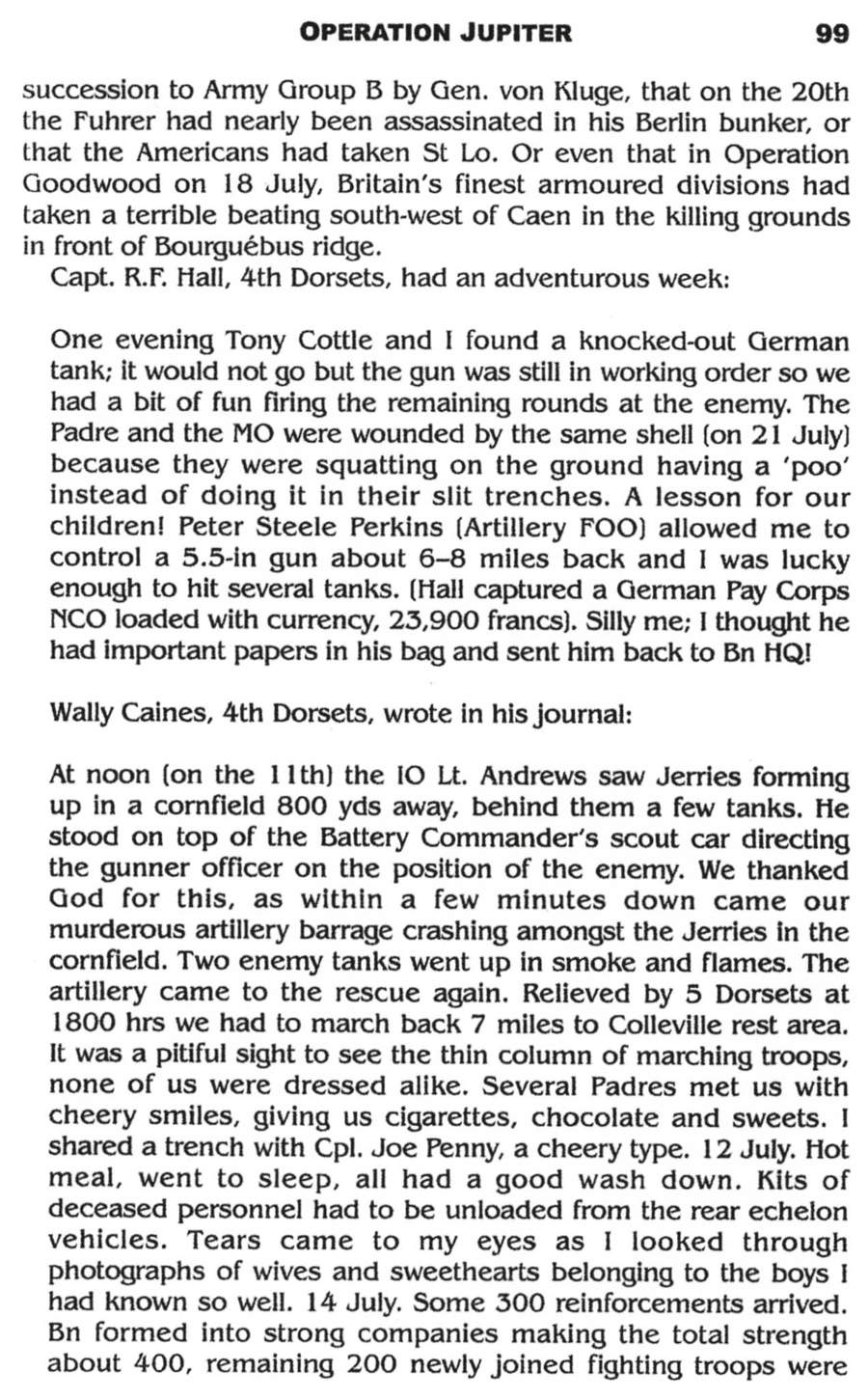
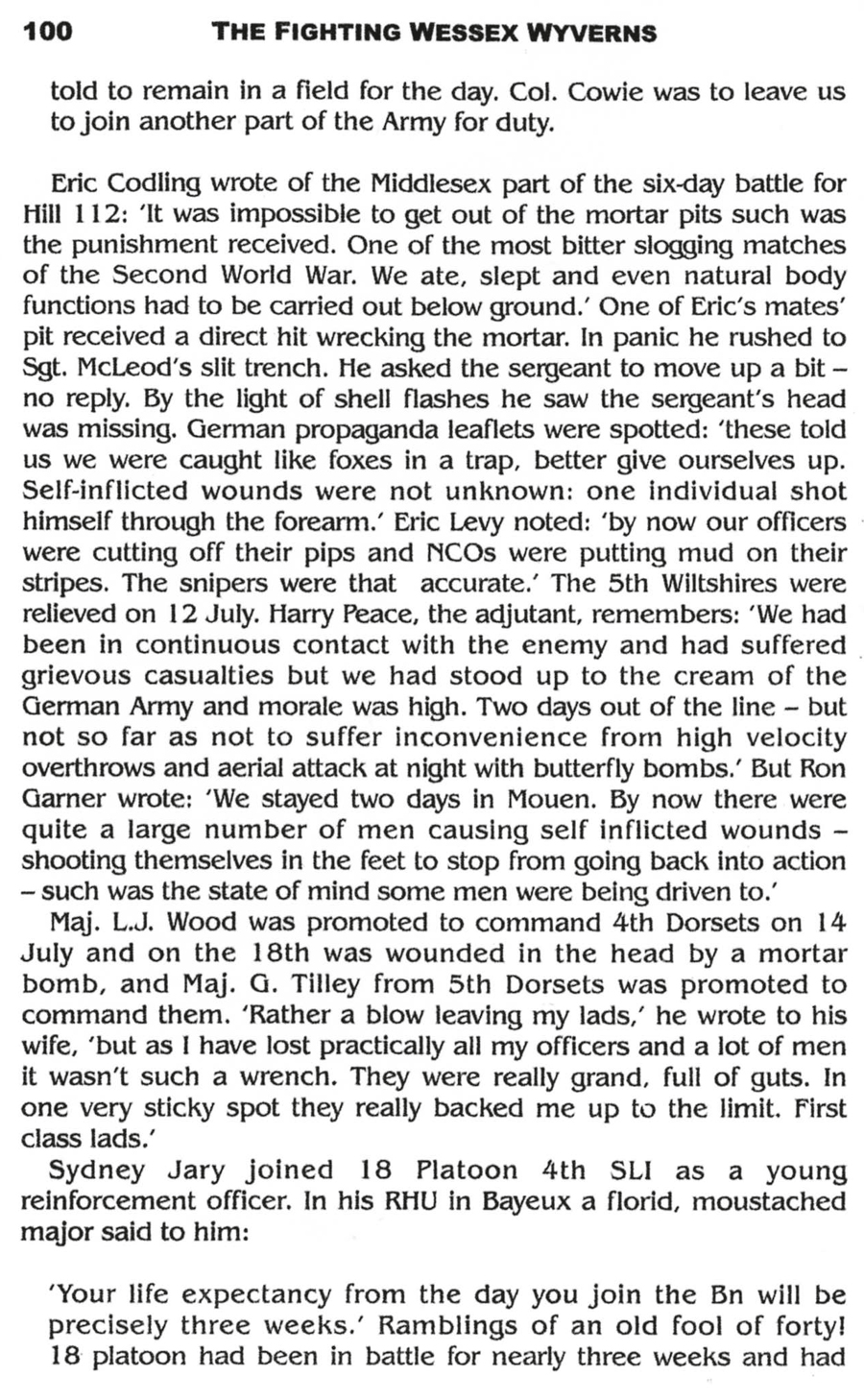

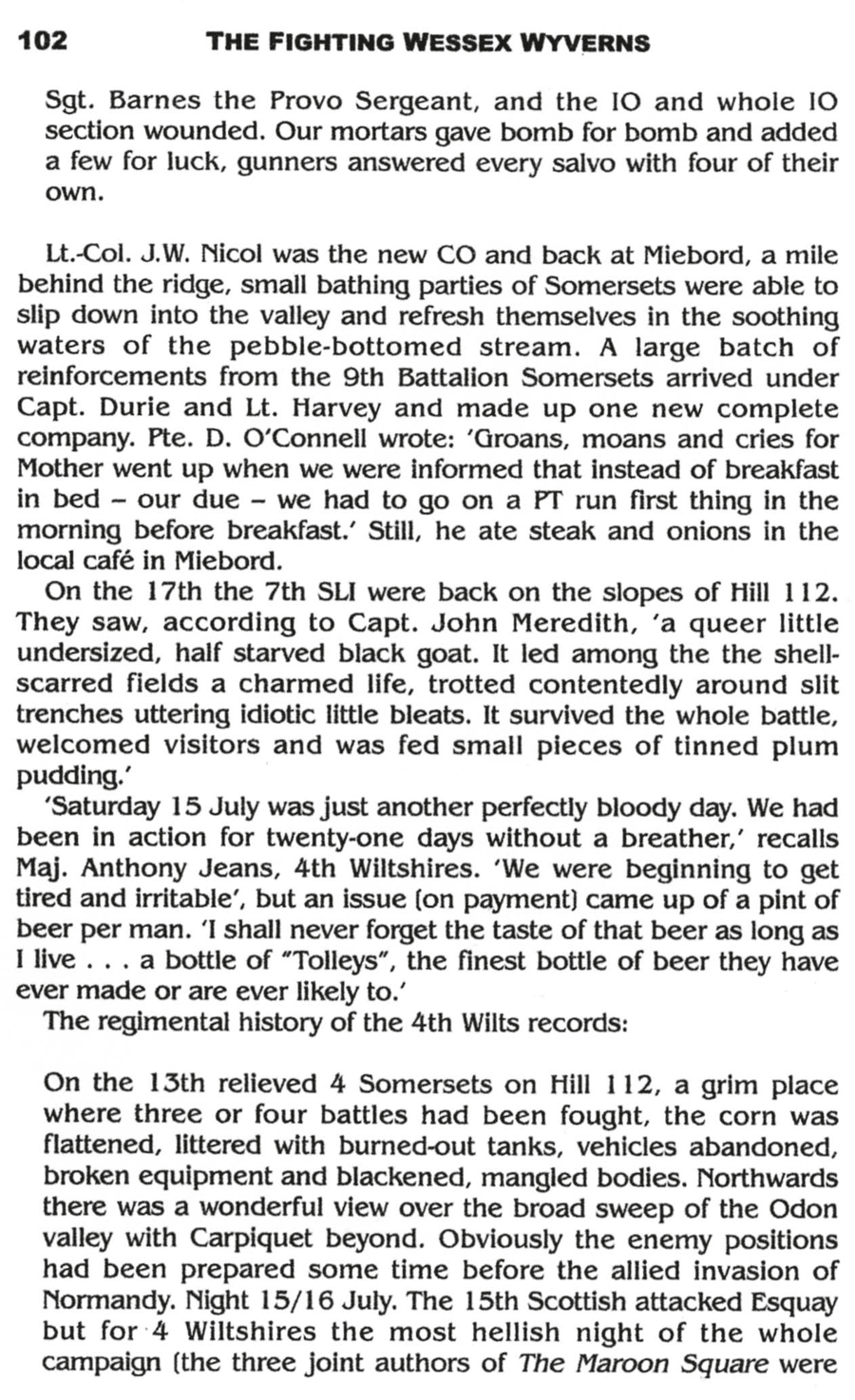
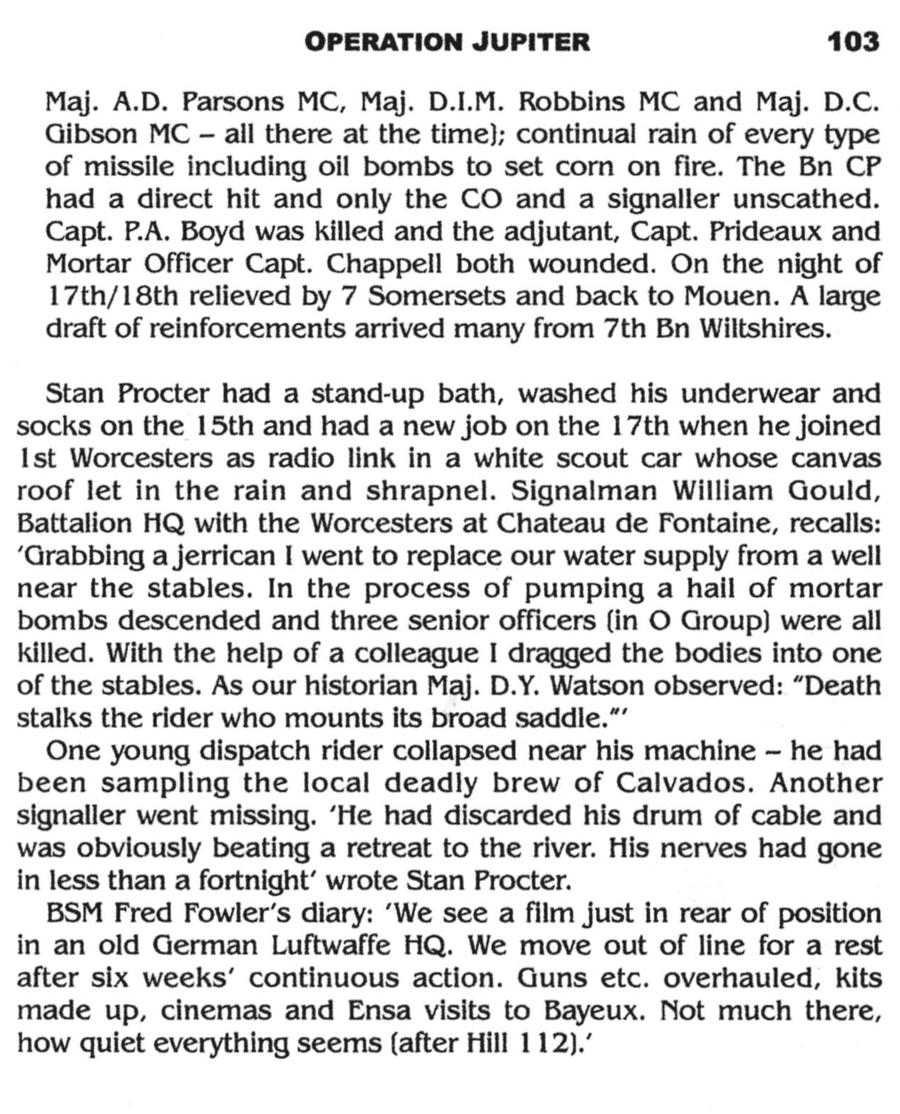
EXTRACTS REPRODUCED BY KIND PERMISSION OF THE AUTHOR
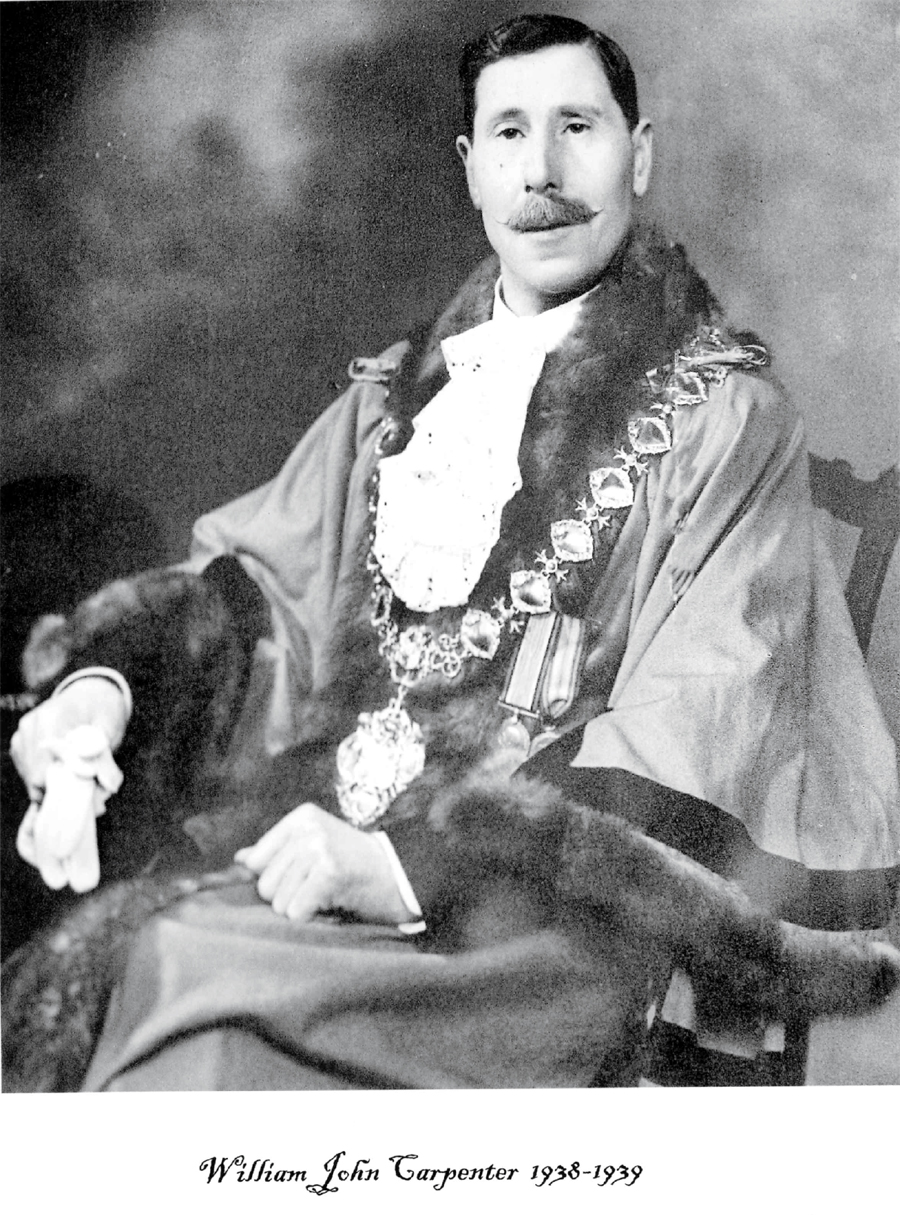
1st Journal 1938-39

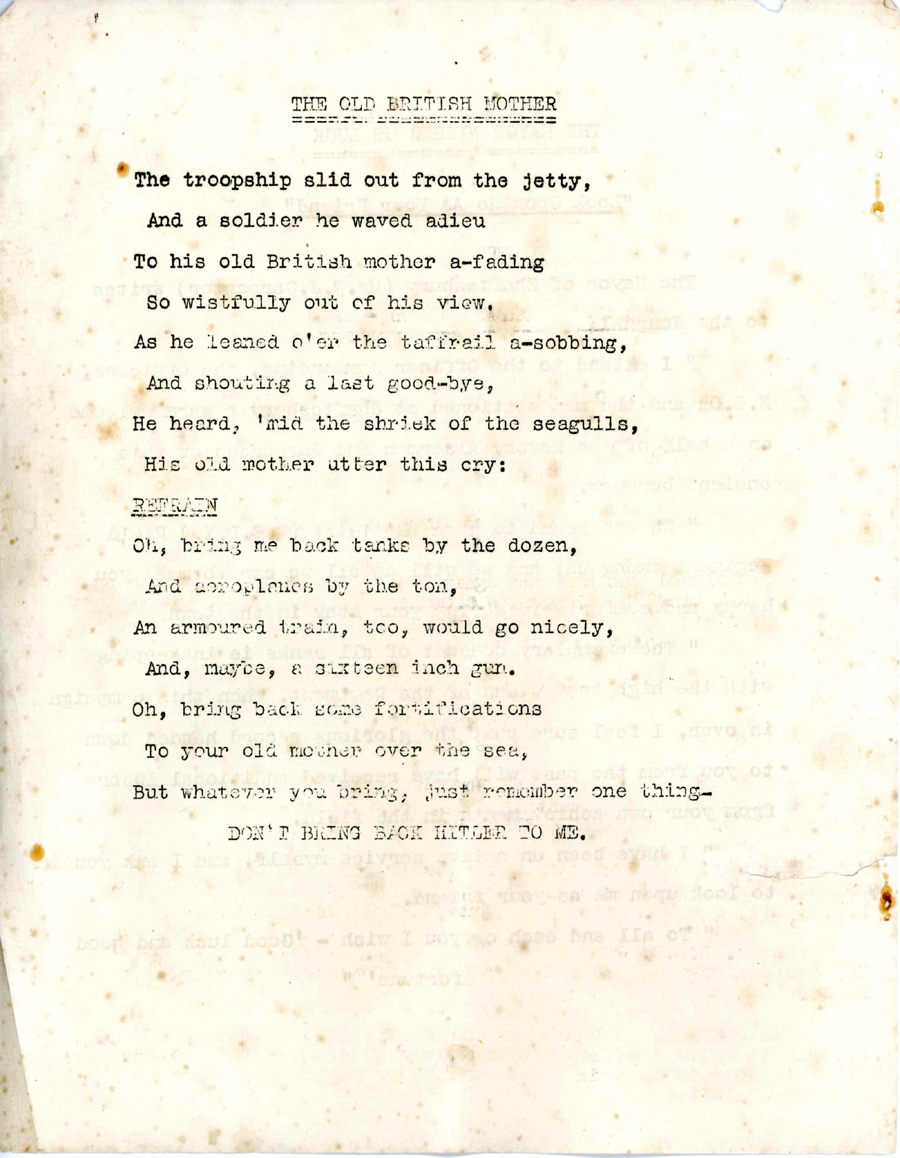
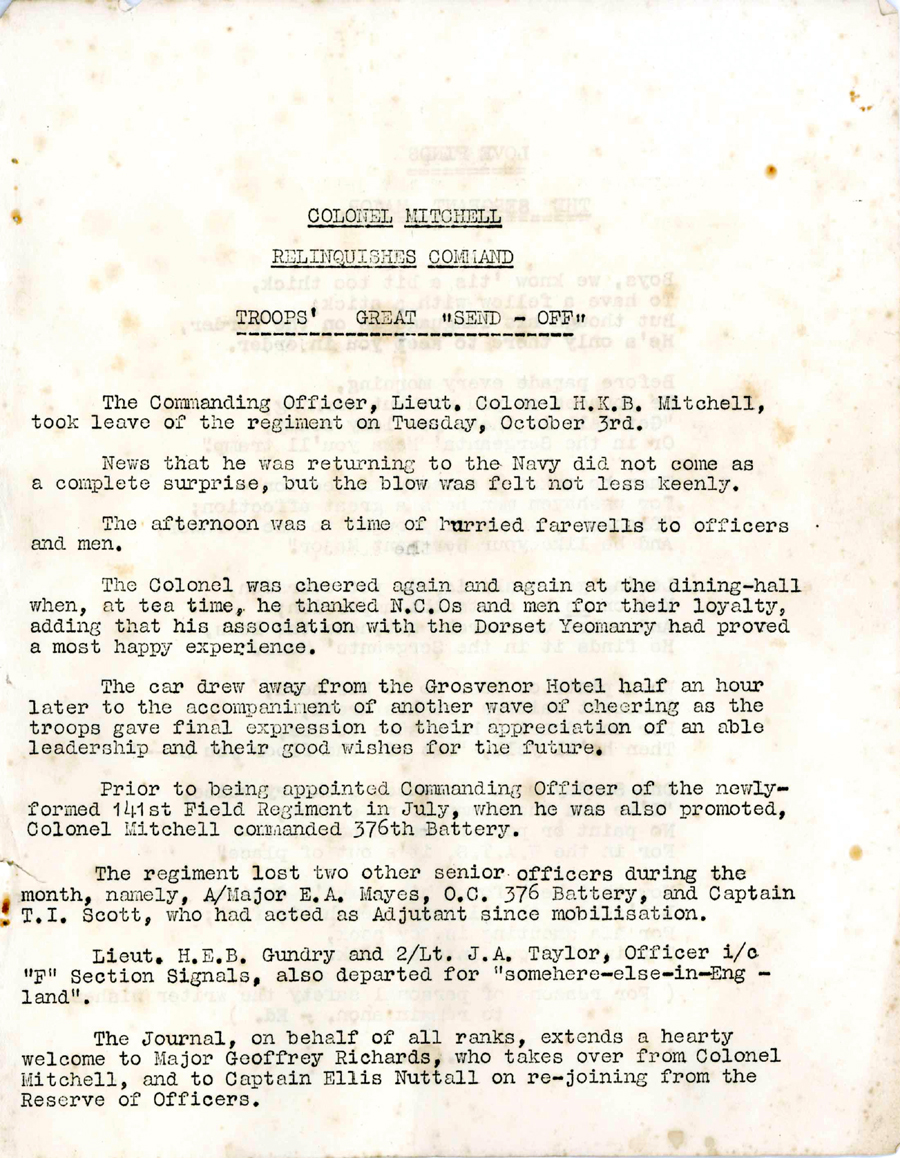
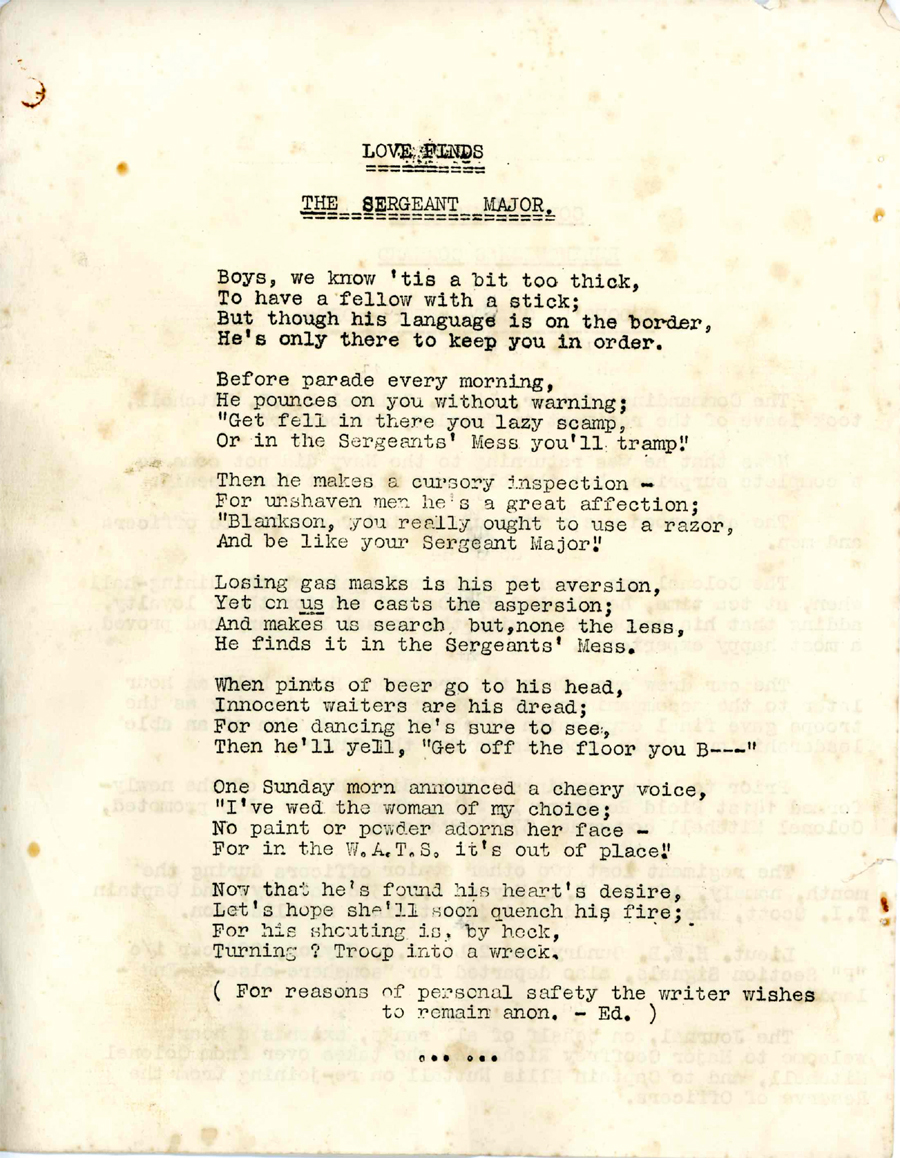
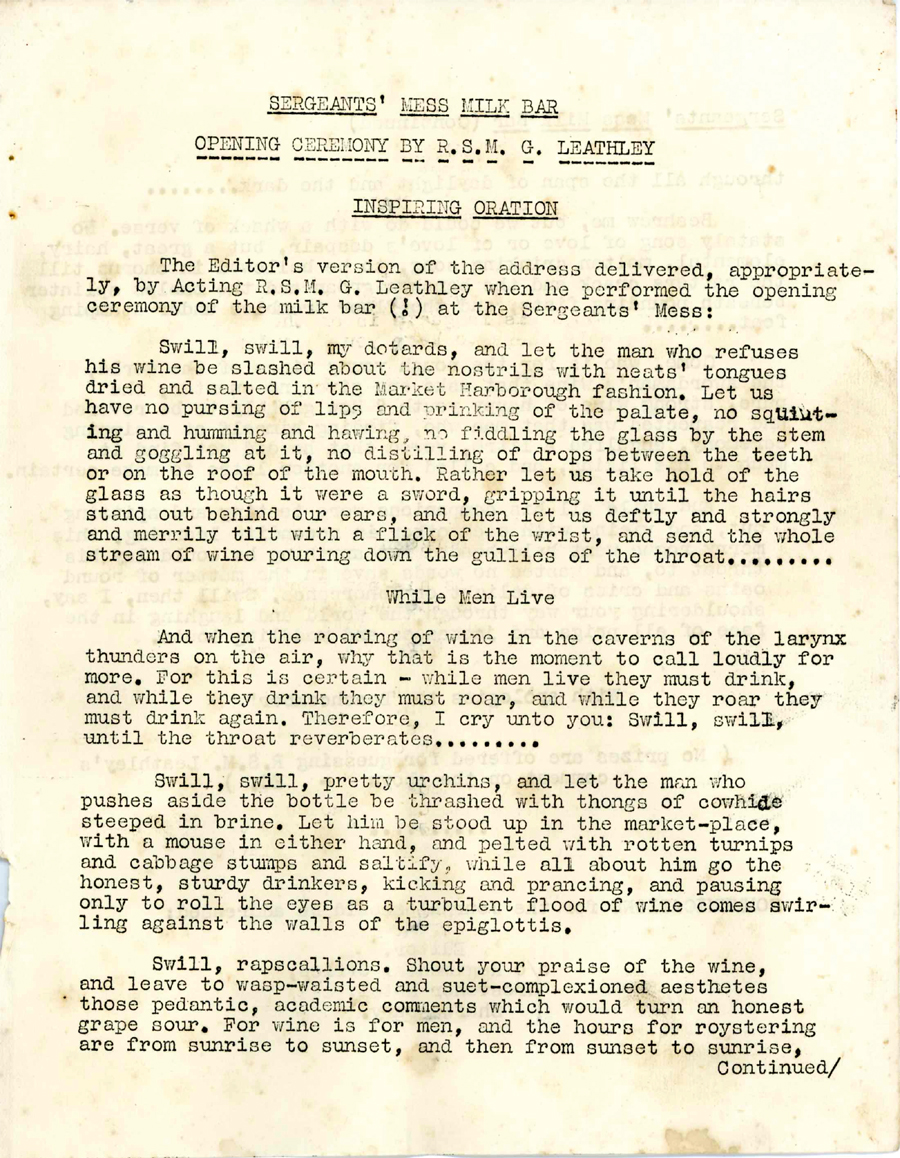
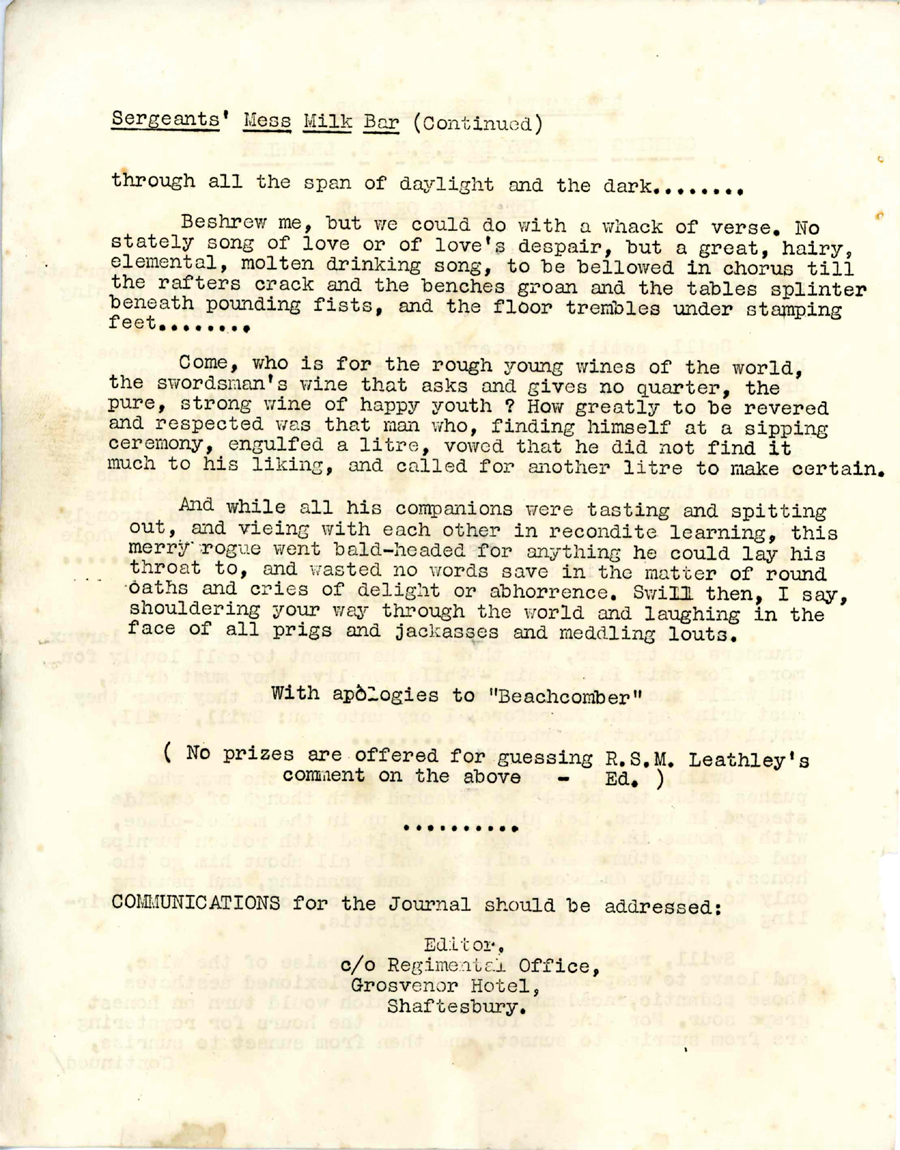
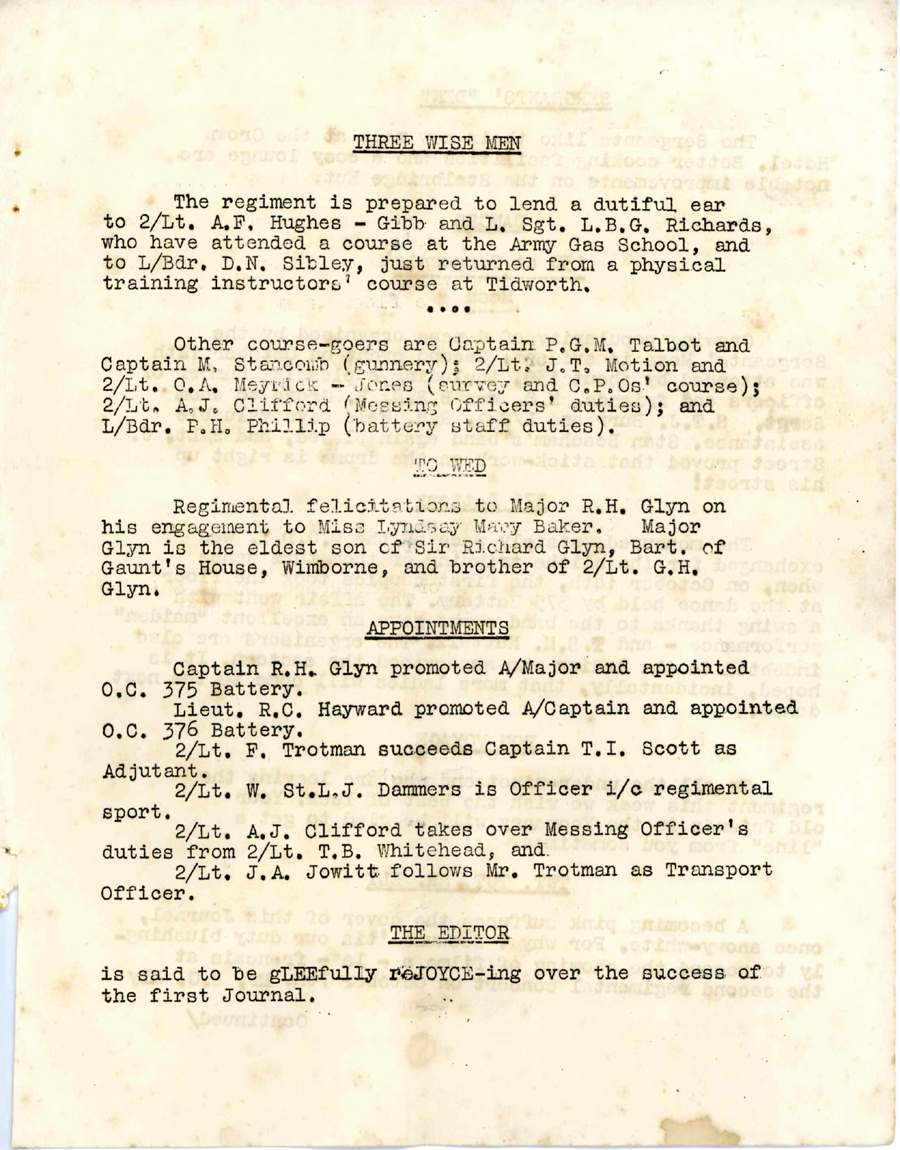
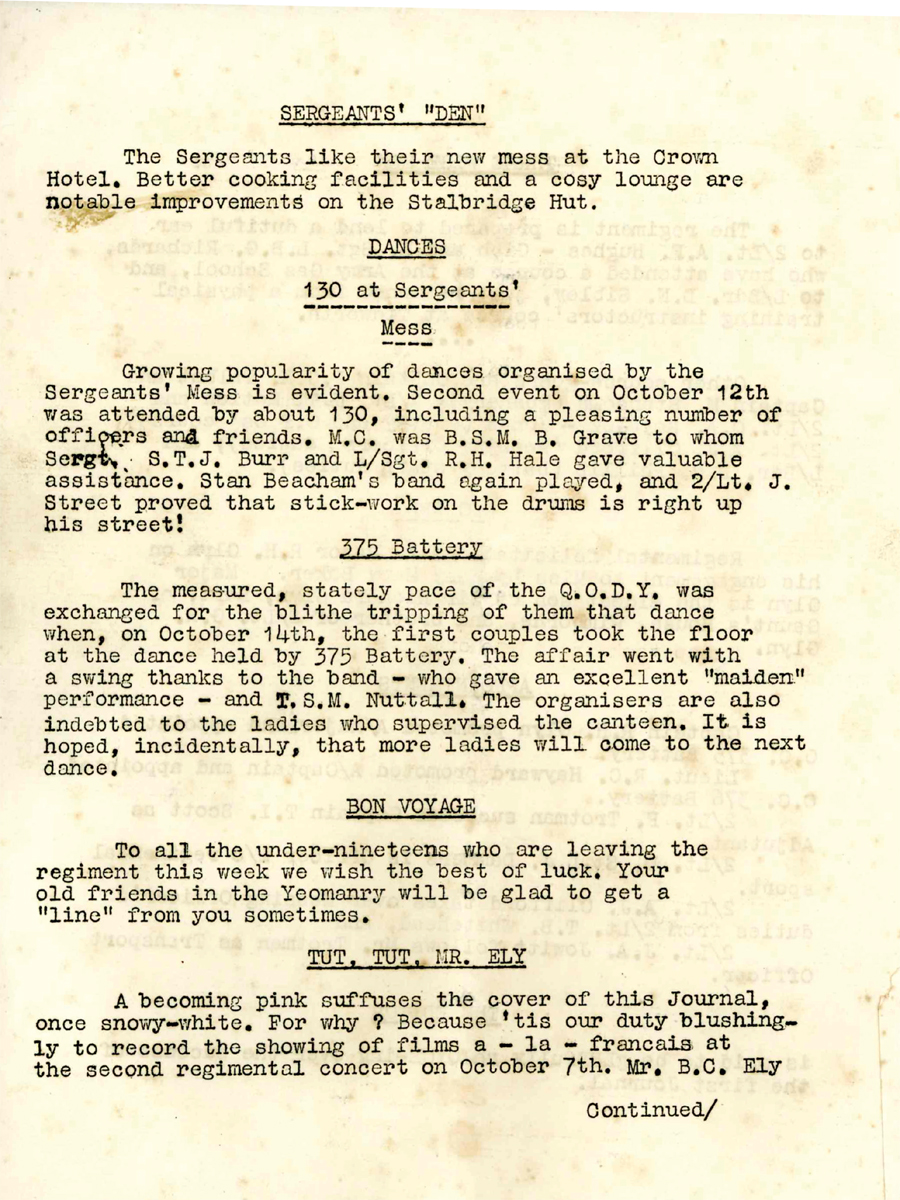
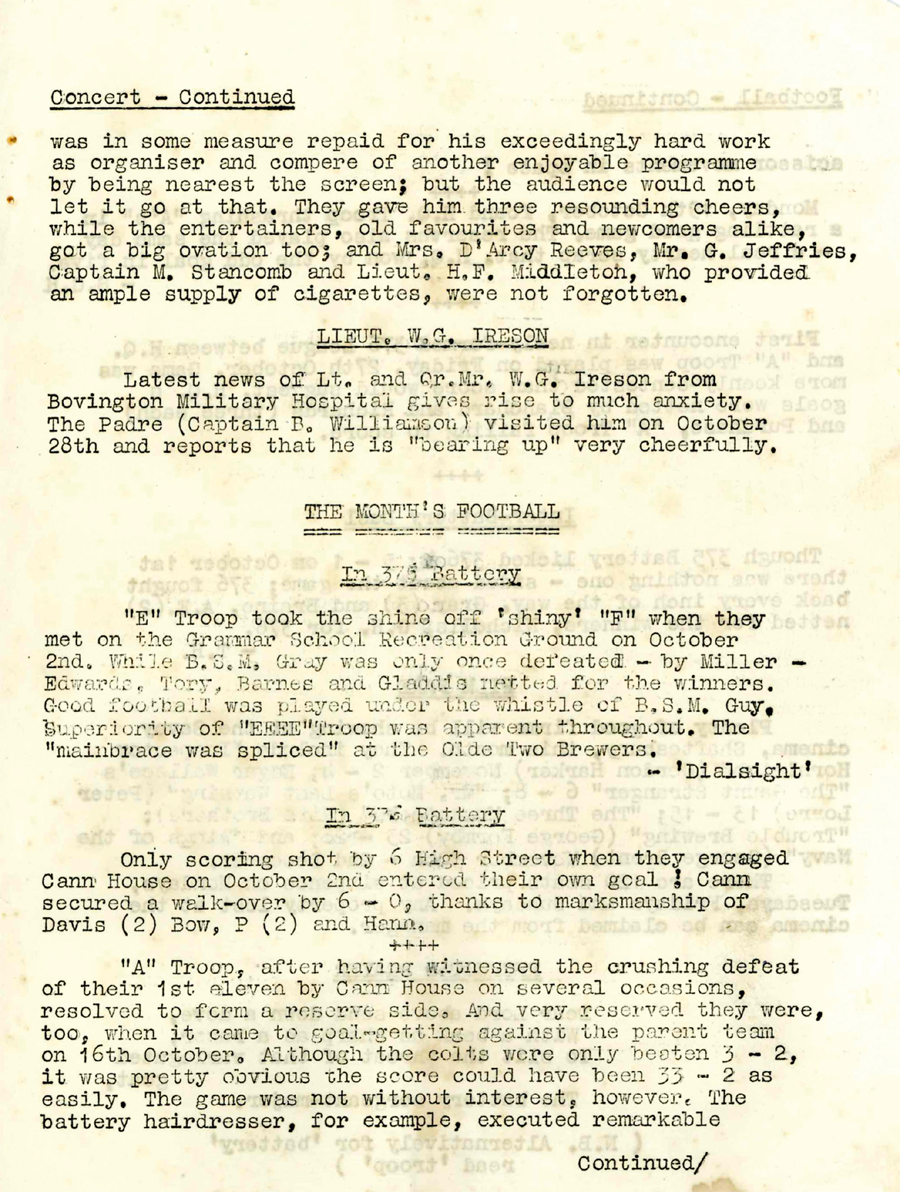
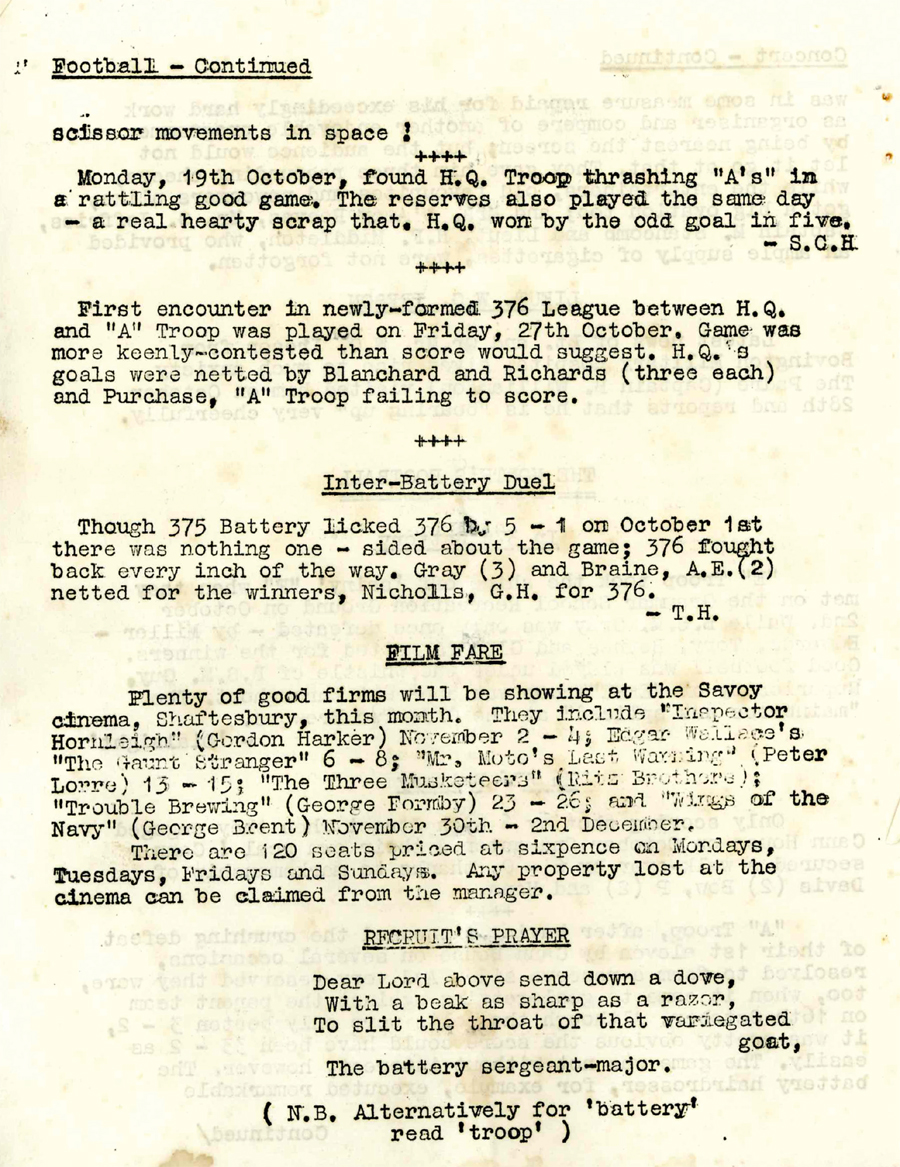

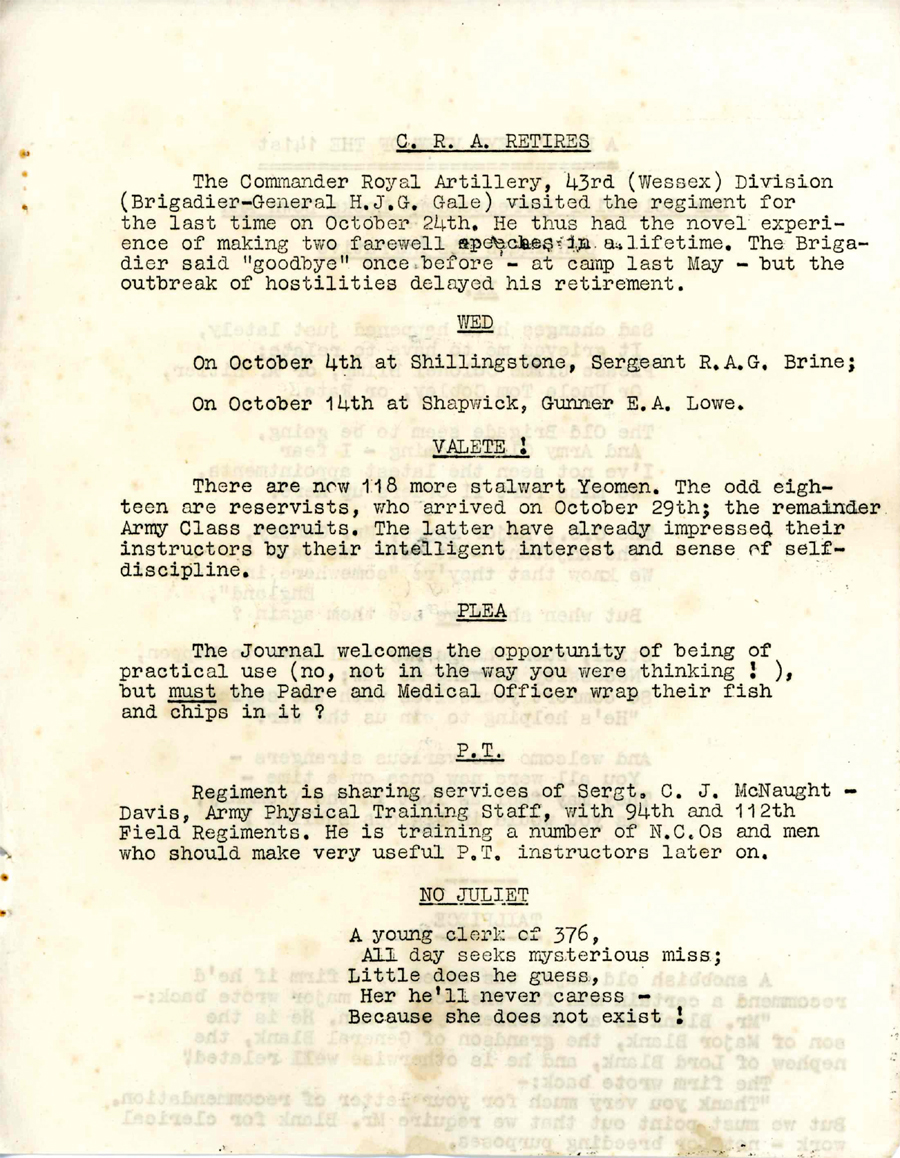
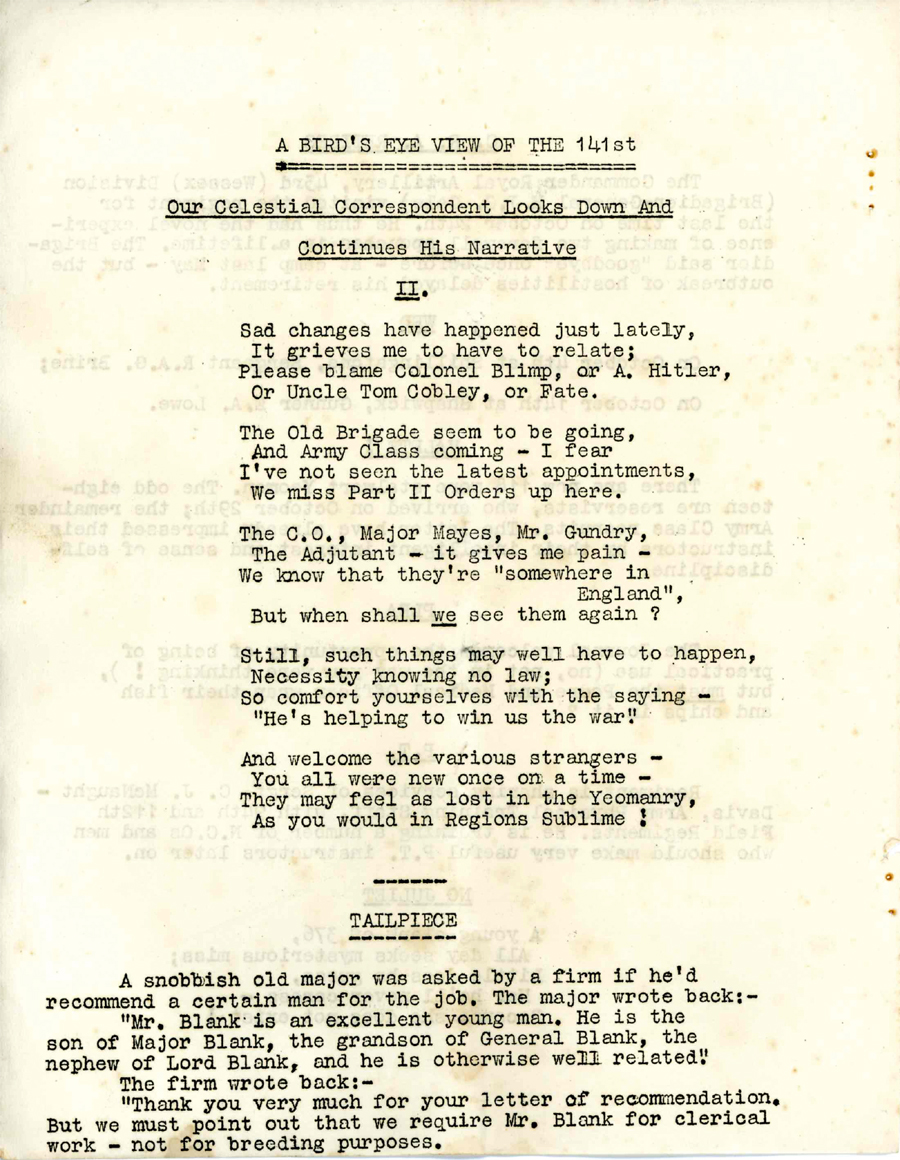

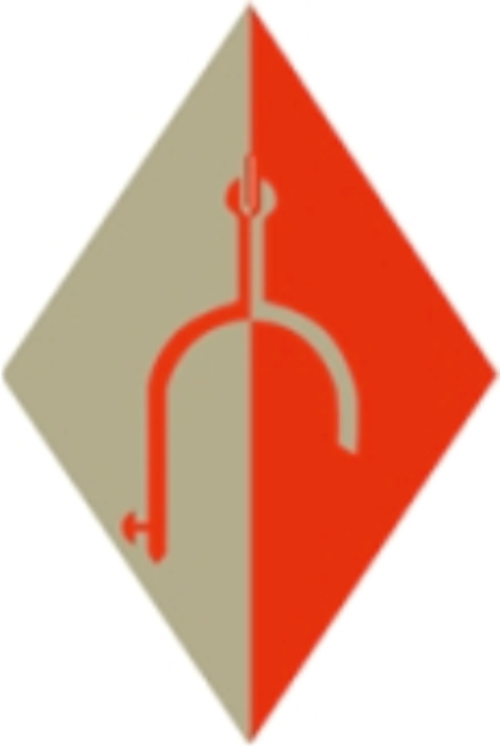
Joint Yeomanry Badge

1940 Yeomanry Cap Badge
Queen's Own Dorset Yeomanry
Queen's Own Dorset Yeomanry
The Queen's Own Dorset Yeomanry was founded as the Dorsetshire Regiment of Volunteer Yeomanry Cavalry in 1794. In response to the growing threat of invasion during the Napoleonic wars. It gained its first royal association in 1833 as The Princess Victoria's Regiment of Dorset Yeomanry Cavalry, and its second in 1843 as the Queen's Own Regiment of Dorset Yeomanry Cavalry.
Boer War
On December 13, 1899, the decision to allow volunteer forces serve in the Second Boer War was made. Due to the string of defeats during Black Week in December, 1899, the British government realized they were going to need more troops than just the regular army, thus issuing a Royal Warrant on December 24, 1899. This warrant officially created the Imperial Yeomanry. The Royal Warrant asked standing Yeomanry regiments to provide service companies of approximately 115 men each. In addition to this, many British citizens (usually midupper class) volunteered to join the new regiment. Although there were strict requirements, many volunteers were accepted with substandard horsemanship/marksmanship, however they had significant time to train while awaiting transport.
The first contingent of recruits contained 550 officers, 10,371 men with 20 battalions and 4 companies, which arrived in South Africa between February and April, 1900. Upon arrival, the regiment was sent throughout the zone of operations. The Queen's Own Dorset Yeomanry provided troops for the 26th Company , 7th Battalion.
World War One
During World War One the Queen’s Own Dorset Yeomanry supplied three regiments for service the original regiment now known as the 1/1st Queen's Own Dorset Yeomanry a second line regiment the 2/1st and a third line regiment the 3/1st.
1/1st Queen's Own Dorset Yeomanry
The 1/1st Queen's Own Dorset Yeomanry was mobilised in August 1914 and assigned to the 1st South Western Mounted Brigade part of the 1st Mounted Division. In September 1914, they were moved to the 2nd South Midland Mounted Brigade , 2nd
Mounted Division. In 1915 they were deployed overseas to Egypt then onwards to participate in the Dardanelles campaign where they served as dismounted troops and were involved in the Battle of Gallipoli the Battle of Sari Bair and the Battle of Scimitar
Hill. After the evacuation of Gallipoli they returned to Egypt in January 1916 and became part of the 6th Mounted Brigade an independent Brigade which was involved in the Battle of Aqqaqia in February 1916. This brigade later joined the Imperial Mounted
Division in February 1917, and took part in the First Battle of Gaza and the Second Battle of Gaza , they later transferred to the Yeomanry Mounted Division in June 1917, for the Third Battle of Gaza and the Battle of Beersheba. In July 1918 the Brigade was redesignated the 10th Cavalry Brigade and the Division the 4th Cavalry Division. The Regiment remained with them in Palestine until the end of the war.[7]
2/1st Queen's Own Dorset Yeomanry
The 2/1st Queen's Own Dorset Yeomanry was formed in September 1914,they converted to a cyclist unit in July 1916. They remained in this role until November 1916 when they took over the horses of the 2/1st Queen's Own West Kent Yeomanry. They again became a cyclist unit in September 1917 prior to moving to Ireland Early in 1918. They remained in Ireland until the end of the war and did not see any active service.
3/1st Queen's Own Dorset Yeomanry
The 3/1st Queen's Own Dorset Yeomanry was formed in 1915, they remained in the United Kingdom until they were disbanded in early 1917.
Between The Wars
After World War I ,It had become clear that cavalry was obsolete and in 1922 it was announced that some Yeomanry Regiments were to become Royal Artillery regiments. The Queen's Own Dorset Yeomanry was reformed in 1920 as a Artillery Brigade. On reorganisation in 1927, two West Somerset Yeomanry Batteries were brigaded with two Batteries of the Queens Own Dorset Yeomanry forming the 94th Brigade R.F.A.[10]
World War Two
The Regiment was mobilised in September 1939. They remained in the United Kingdom until June 1944 when they sailed for France and landed in Normandy on D plus 21, attached to the Guards Armoured Division. On the June 29 , 1944 the Regiment took part in its first action of the Second World War at Pubot en Bassin it was involved in the divisions battles at Carpiquet Aerodrome , Caen and Miny Bocage. They were also with the Guards Armoured from Falaise to Brussels and the assault crossings of the Albert and Escaut Canals. Their last actions of the war were during the Battle of the Reichswald and to provided support for the Rhine crossing. After the war the Regiment was in the area of Aachen in an occupational role.
Post War
In 1947 the Regiment was reformed with the sub title 55th Field Regiment RA until February 1967, until the reduction of the Territorial Army when it ceased to exist as a Regiment. The final parade was held on Sunday 26th February. The salute was taken by the Lord Lieutenant of Somerset, Lord Hylton.
The Queen's Own Dorset Yeomanry was reformed in 1971 as "A" Squadron of the Royal Wessex Yeomanry , the other squadrons of the regiment are formed by other old yeomanry regiments now reduced to the strength of one squadron;
Royal Wiltshire Yeomanry (RWY) , B Squadron
Royal Gloucestershire Hussars (RGH) , C Squadron
Royal Devon Yeomanry (RDY) , D Squadron
The Regiment has three roles: B,C and D Squadron provide replacement Challenger 2 turret crewmen to the Regular Army. Regimental Headquarters and A Squadron (Dorset Yeomanry) Armour Replacement Squadron: to develop Armour Replacement doctrine and provide the infrastructure to support the Logistic brigades.
Queen’s Own Dorset Yeomanry
Active 1974-Present Day
Country Great Britain
Allegiance British Arms
Branch Yeomanry
Boer War
Yeomanry
World War One
Role - Yeomanry
Infantry
World War Two
Artillery
Boer War
One Company
World War One
Three Regiments
Size - World War Two
One Regiment
Current
One Squadron
Boer War
South Africa 1900-1902
World War One
Battle of Gallipoli
Battle of Sari Bair
Battle of Scimitar Hill
Battle of Aqqaqia
First Battle of Gaza
Battle Honours Second Battle of Gaza
Third Battle of Gaza
Battle of Beersheba
World War Two
No battle honours were awarded. It is tradition within artillery units that the Regiment’s guns represent its colours and battle honours.
The British 74th (Yeomanry) Division was a First World War Infantry Division formed in Egypt from brigades of Dismounted Yeomanry (Territorial Army Cavalry).
On 14 January 1917, the GOC Egyptian Expeditionary Force, Sir Edmund Allenby, gave orders for the re-organisation of the 2nd, 3rd and 4th Dismounted brigades of Yeomanry - at the time all were serving on Suez Canal defences - and for their re-designation as the 229th, 230th and 231st Infantry brigades.
The brigades were organised as a Division, which began to assemble on 4 Mar 1917 near El Arish.
The divisional Artillery did not join until July, by which time the Division had already taken part in its first action, the second Battle of Gaza.
The Division's insignia was a broken spur to signify that it was once a mounted division and now served as Infantry.
During the Battle of Beersheba on 31 October 1917, the Division, as part of Chetwodes XX Corps, captured the Turkish fortifications west of Beersheba.
After further service in Palestine, the Division was ordered to the Western Front, landing in Marseilles in May 1918. It then concentrated near Abbeville by 18 May 1918.
The Division was in Ath (Belgium) at the armistice. Demobilisation happened steadily throughout early 1919. The final departure of Divisional Headquarters was on 19 July 1919, when this unusual Division finally ended service.
Whereas the broken spur and shape of the TRF are taken from the 74th (Yeomanry) Division the colours on the left and right are not. The two colours used scarlet and buff are in fact the facing colours (ie the colours of the collars and cuffs on full dress uniform.
Scarlet for the Royal Wiltshire Yeomanry, Royal Devon Yeomanry and Queens Own Dorset Yeomanry and Buff for the Royal Gloucestershire Hussars.
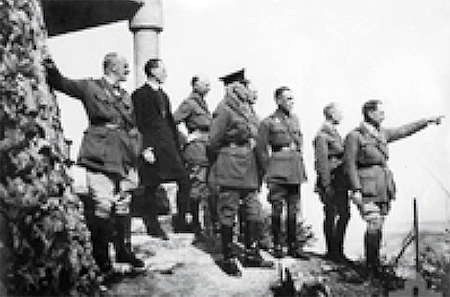
Whereas the broken spur and shape of the TRF are taken from the 74th (Yeomanry) Division the colours on the left and right are not. The two colours used scarlet and buff are in fact the facing colours (ie the colours of the collars and cuffs on full dress uniform.
Scarlet for the Royal Wiltshire Yeomanry, Royal Devon Yeomanry and Queens Own Dorset Yeomanry and Buff for the Royal Gloucestershire Hussars.

Private A.E.B. Collis Queen’s Own Dorset Yeomanry 1940
Father of current Mayoress

